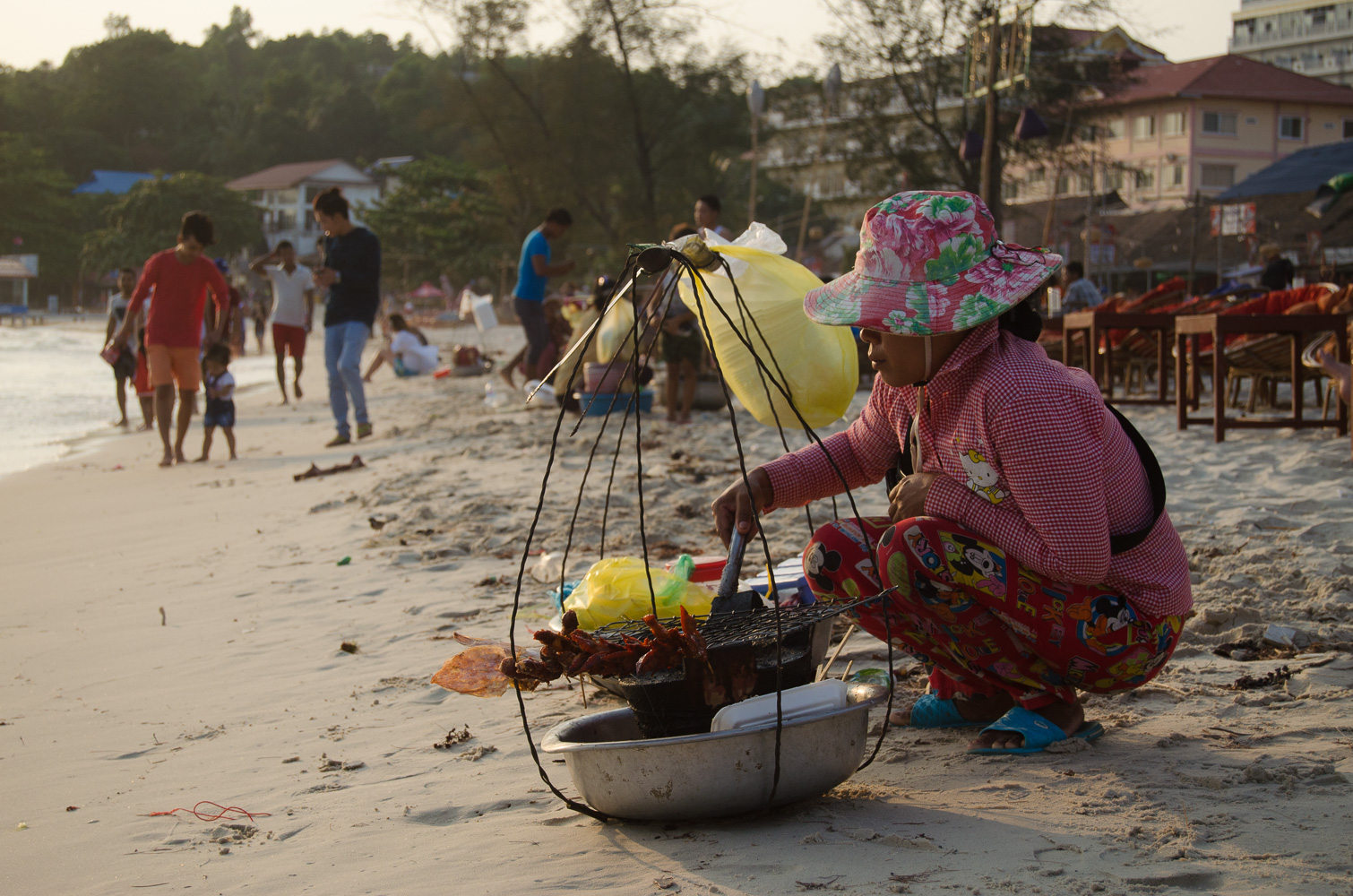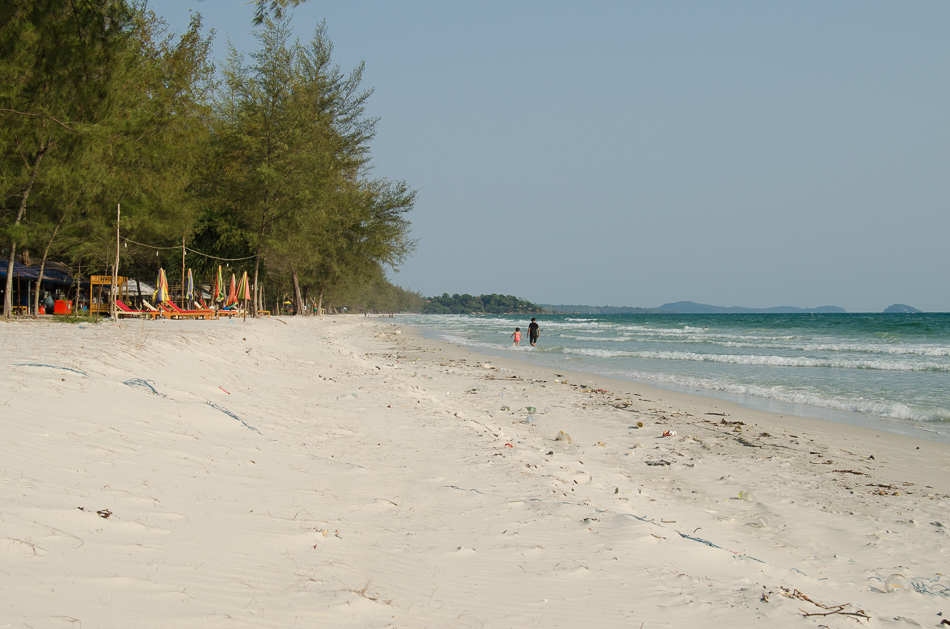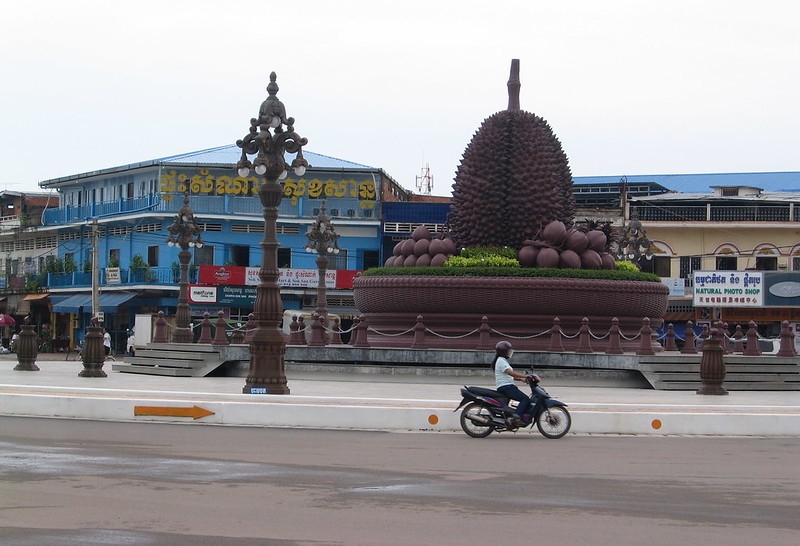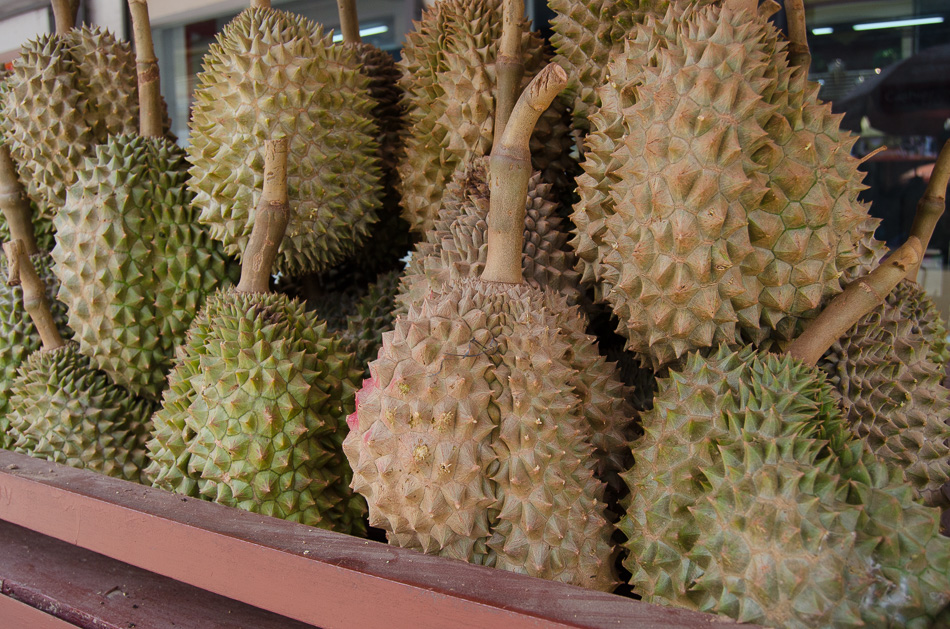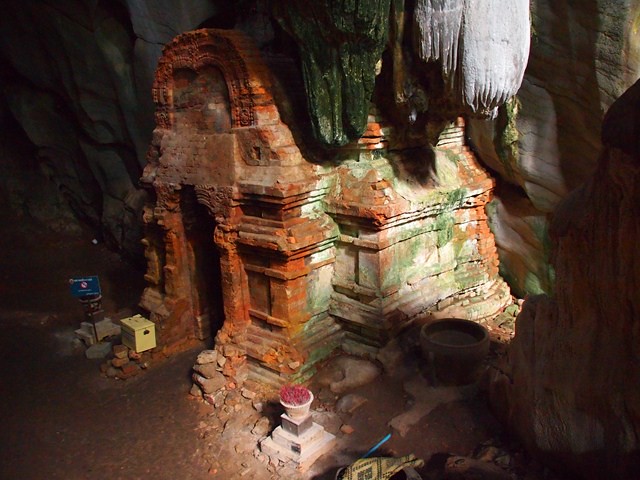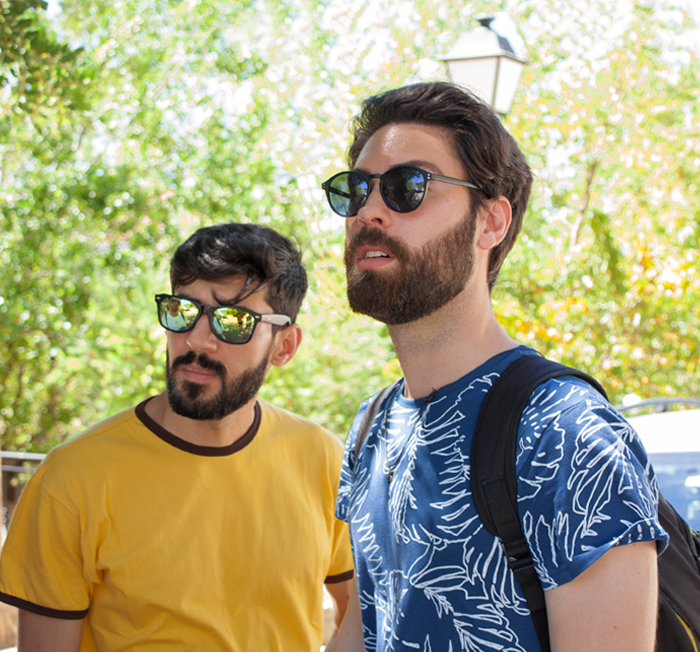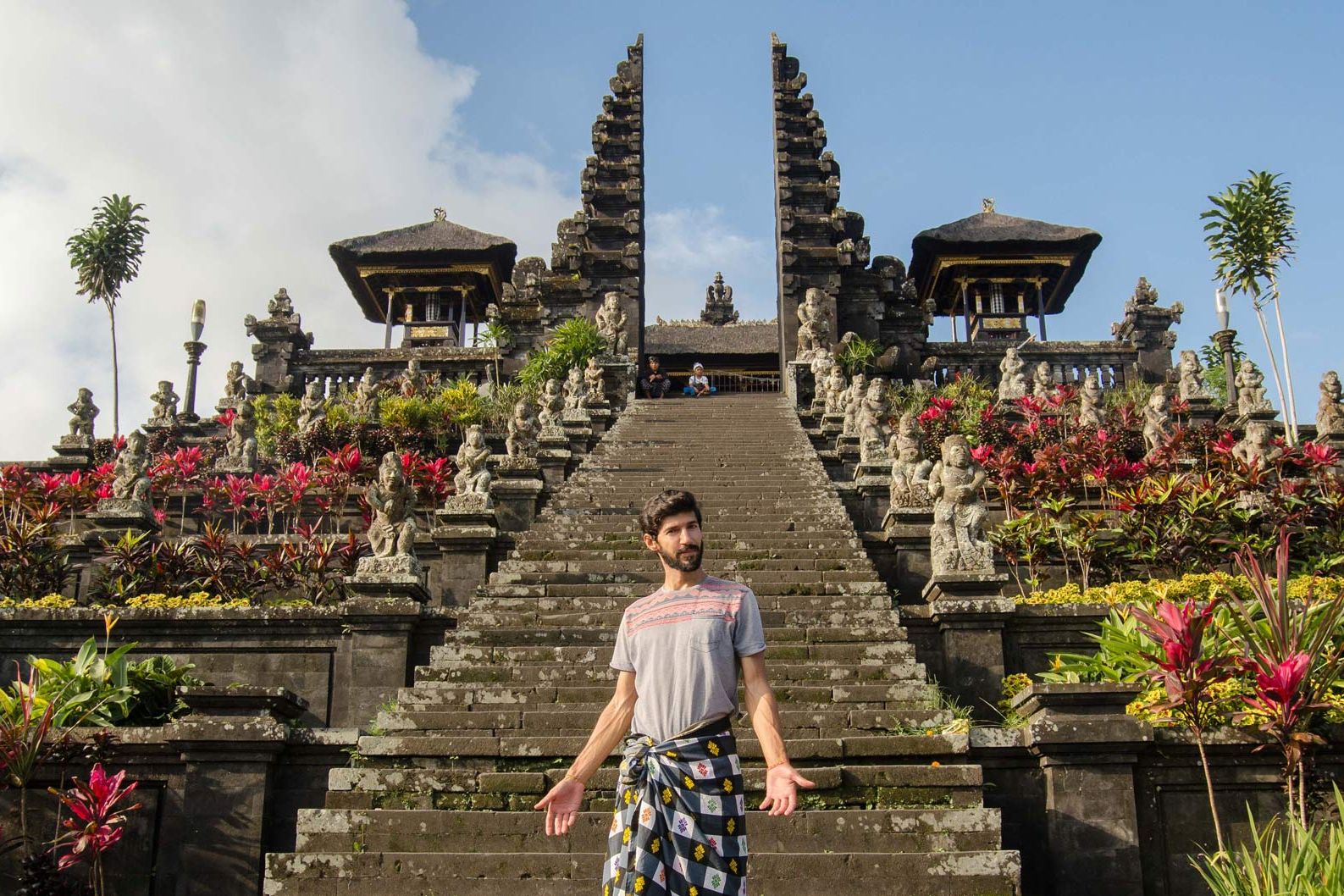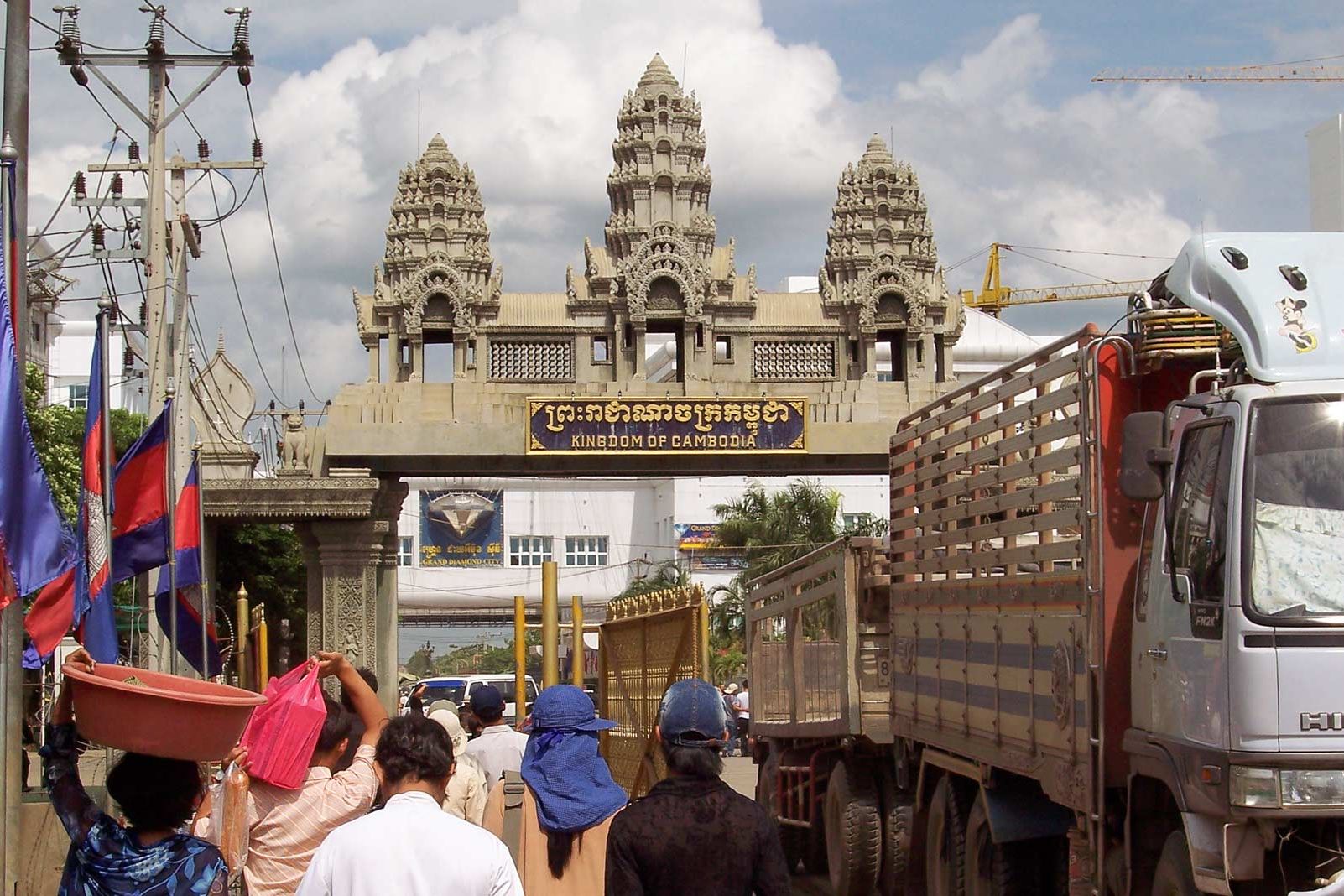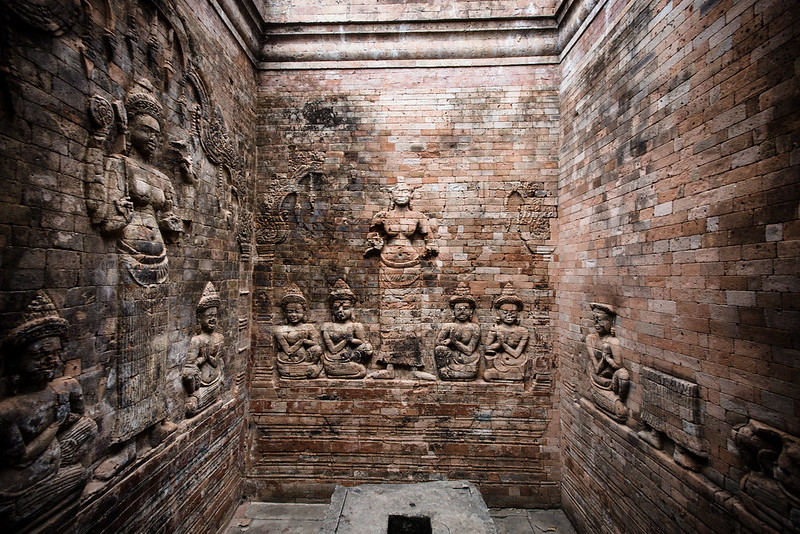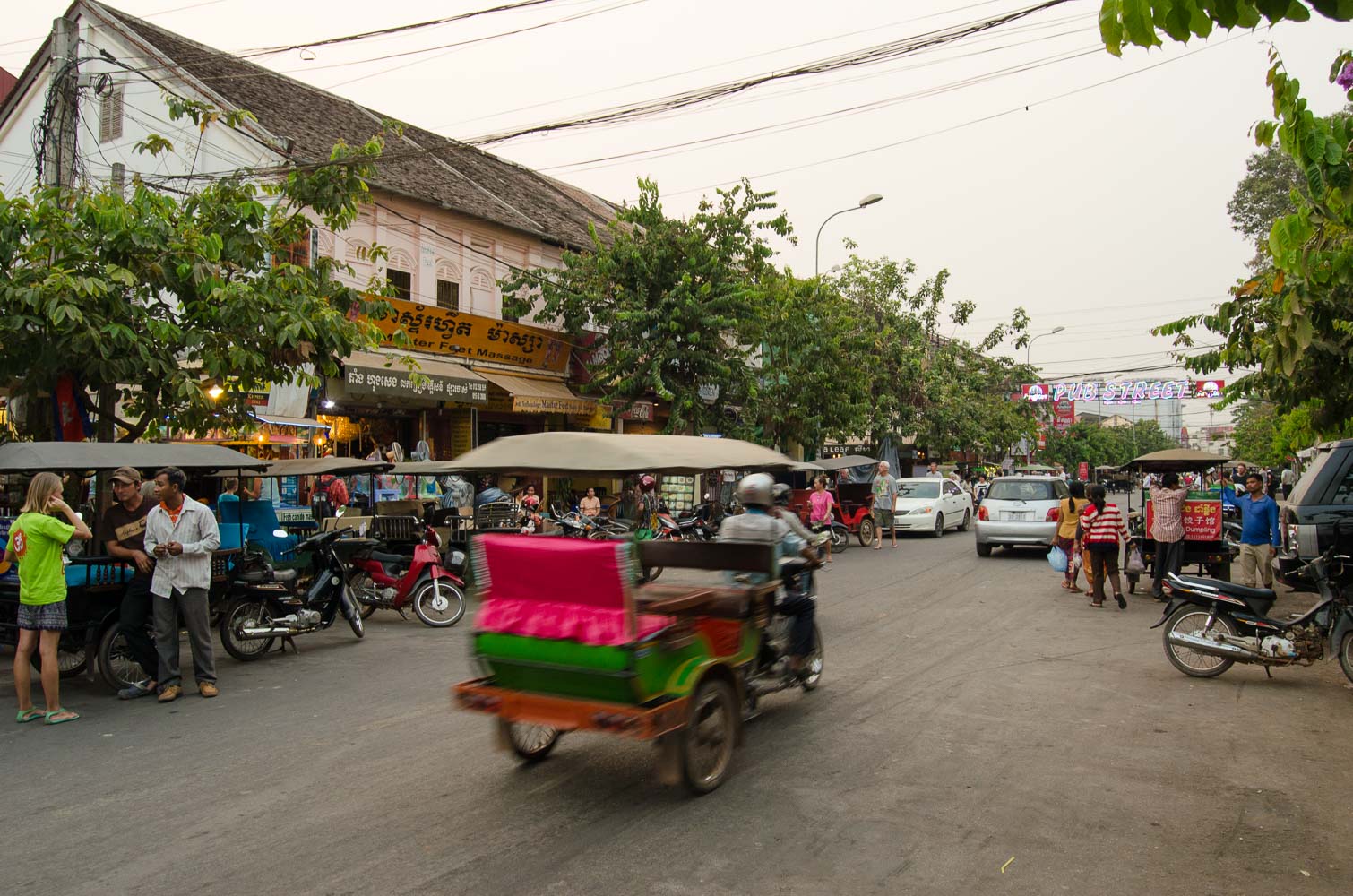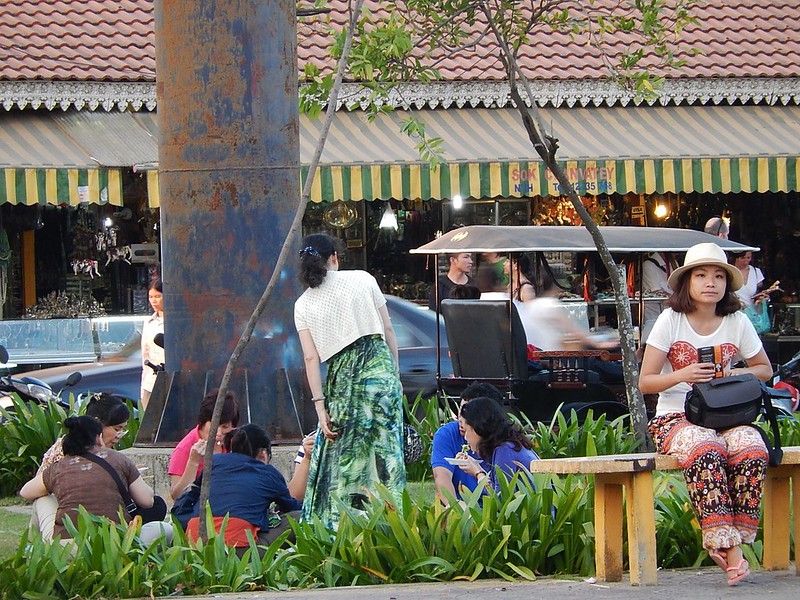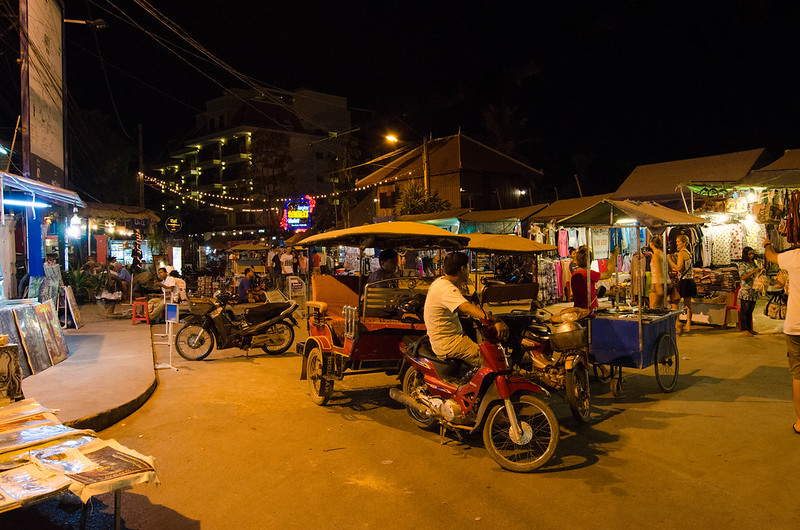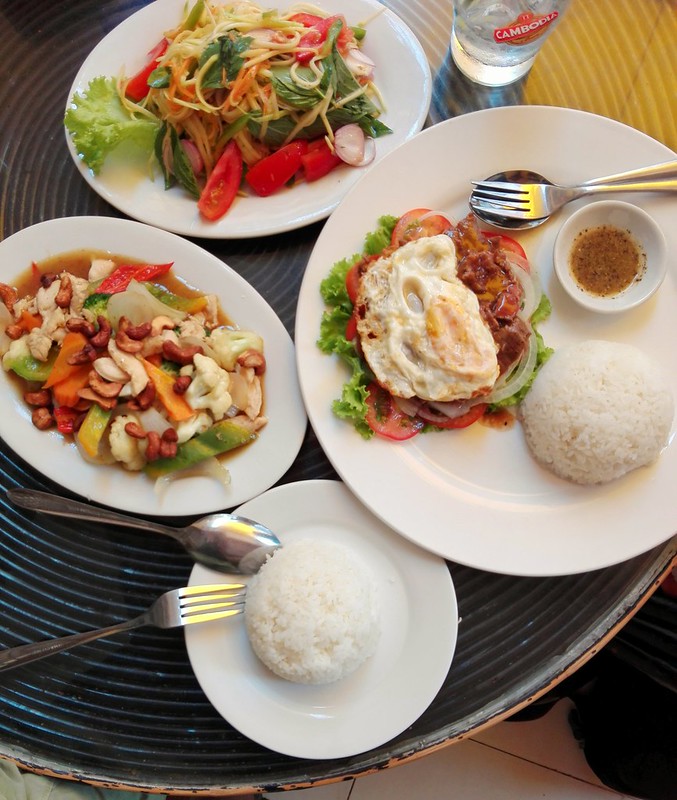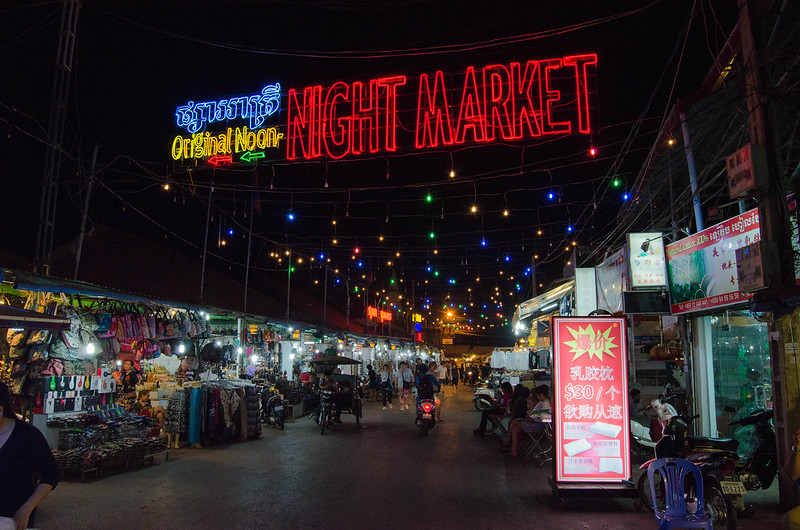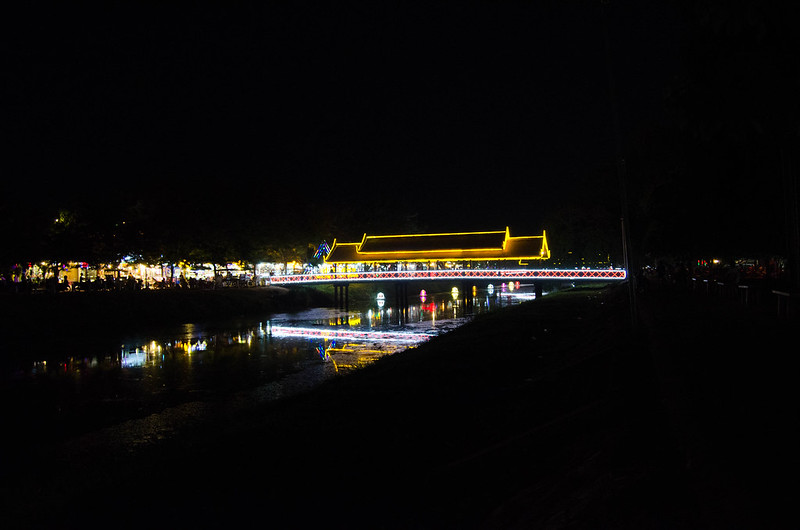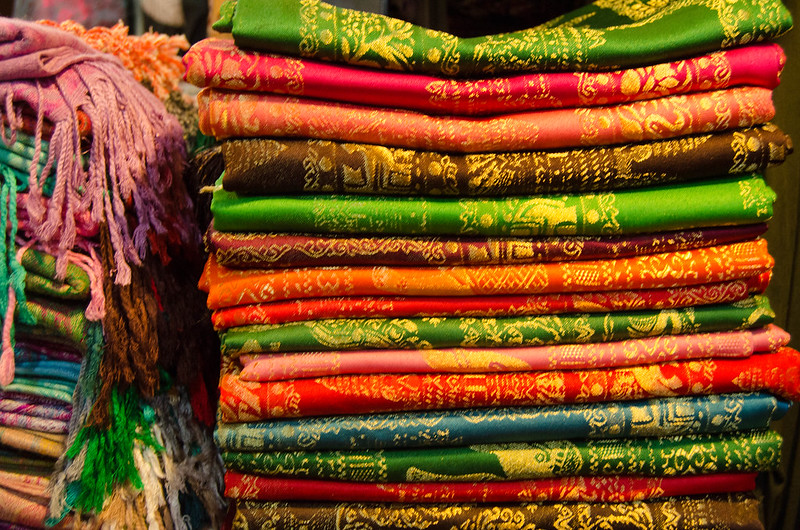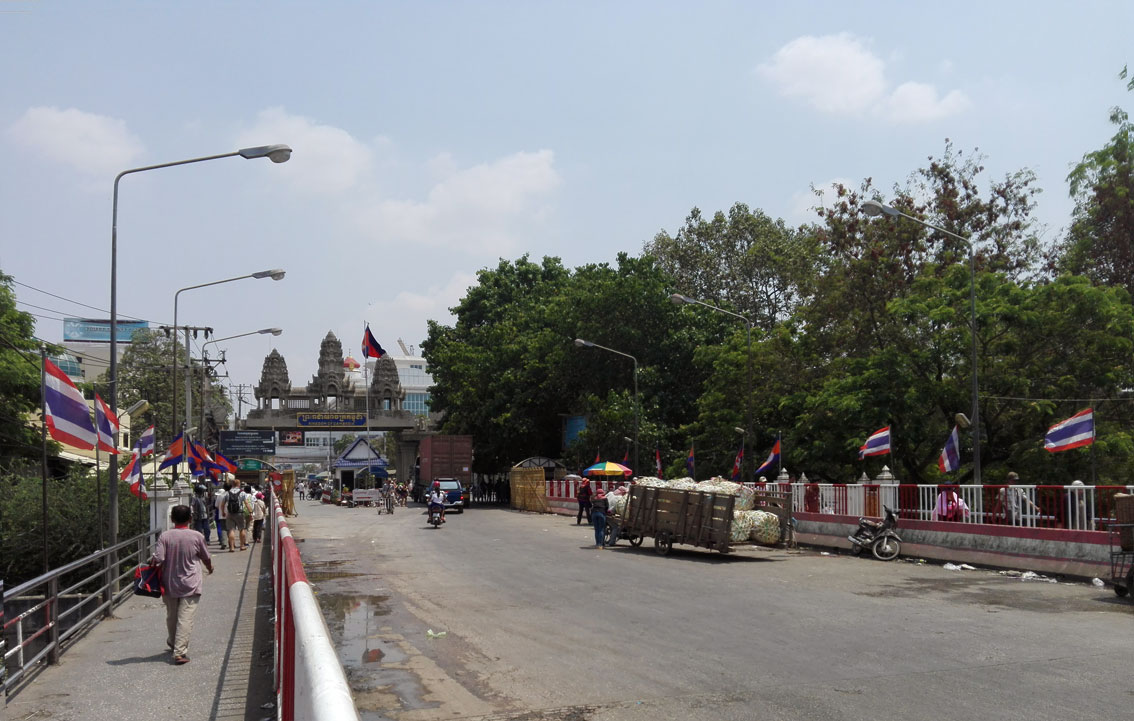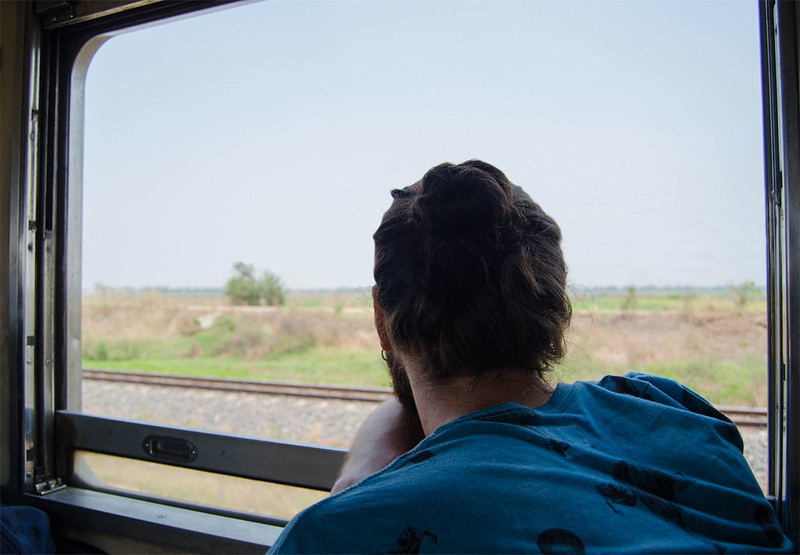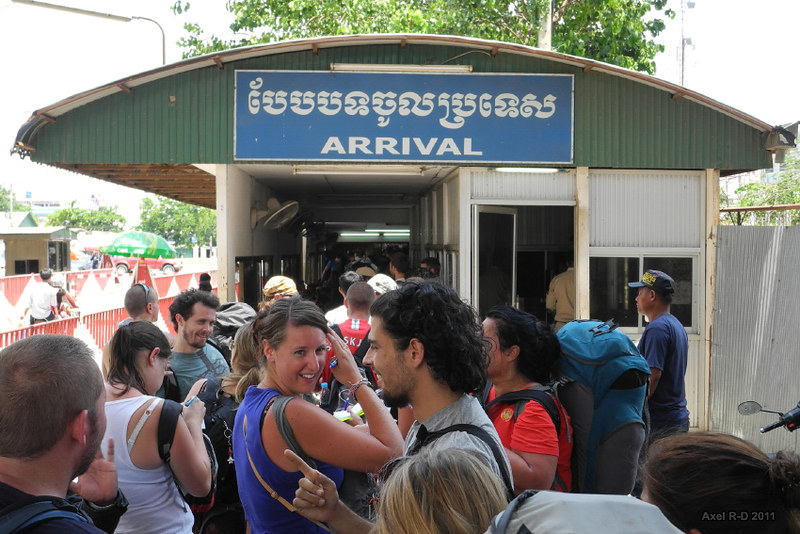Sihanoukville, Kampot and Kep: Southern Cambodia
Sihanoukville, Kampot, and Kep are three neighboring cities on the southern coast of Cambodia that cater to different types of travelers. If you’re more of a party animal and enjoy a younger backpacker vibe, bounce over to Sihanoukville. If you like a greener and more relaxed environment, Kampot is a great choice. Finally, there’s Kep, a mellow province that combines the best of the latest with a bonus: seafood!
Sihanoukville
We first arrived near Sihanoukville after a 5-hour trip from Phnom Penh with Capital Tours. It was a $5 bus ride with TV, Cambodian karaoke, and a honking bus driver with Tourette’s syndrome of the hands! Apparently, honking it’s like a national habit—everyone is really committed to it.
We bought a bus ticket straight to Sihanoukville center, but that didn’t happen. We were dropped off at a random gas station, with a horde of tuk-tuk drivers expecting us. As the bus stopped, most of them reached for the luggage compartment below, while others stepped on the bus and started shouting:
– Sihanoukville! Exit here. Exit!
A bit confused and concerned to see our backpacks being taken away, we got off the bus along with all the other tourists, while the remaining locals on the bus laughed. As soon as all foreigners got off, the bus left straight to Sihanoukville.
There we were, stuck in an odd gas station with no other choice but to haggle a tuk-tuk ride to Sihanoukville. Everyone was furious and the negotiation process got a little bit heated. We ended up splitting a tuk-tuk with two Swedish girls and paid $4 each for what ended up being an 8-minute ride.
Another transport scheme, just like the one at the Poipet border.
If you haven’t booked your bus to Sihanoukville yet and want to do it through a reliable platform, go to www.bookaway.com. You can use the code “gravy5″ at checkout to get 5% off the ticket price.
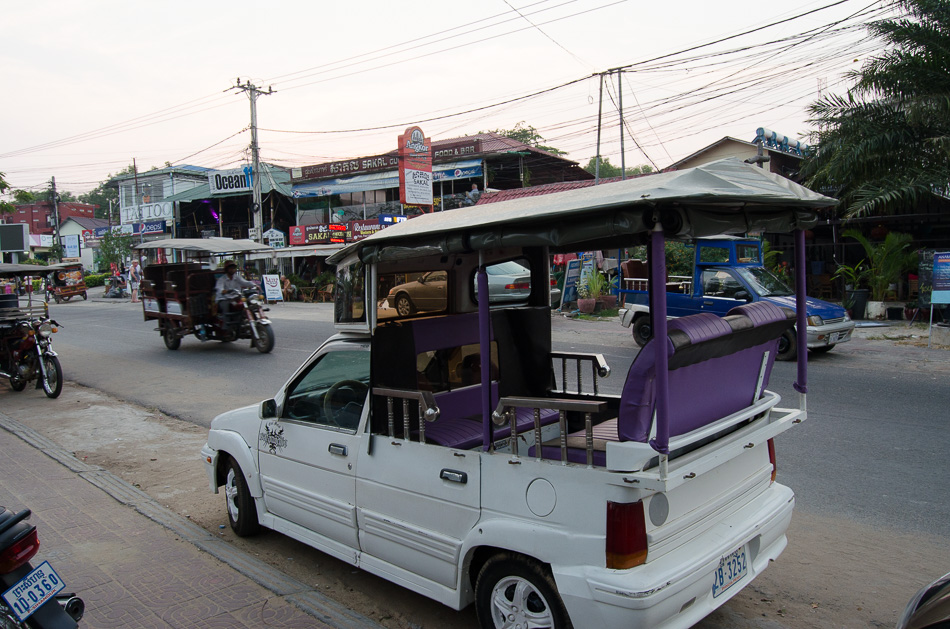
At Sihanoukville, we stayed in Zana Beach Guesthouse for $12 the room, is not the cheapest but quite nice and an 8-minute walk from Serendipity beach.
Tons of new accommodations are being built there as a result of tourist demand, unfortunately, this is having a big toll on the landscape as rubble ends up everywhere: sand, ocean, surf areas, gutters, and mountain slopes.
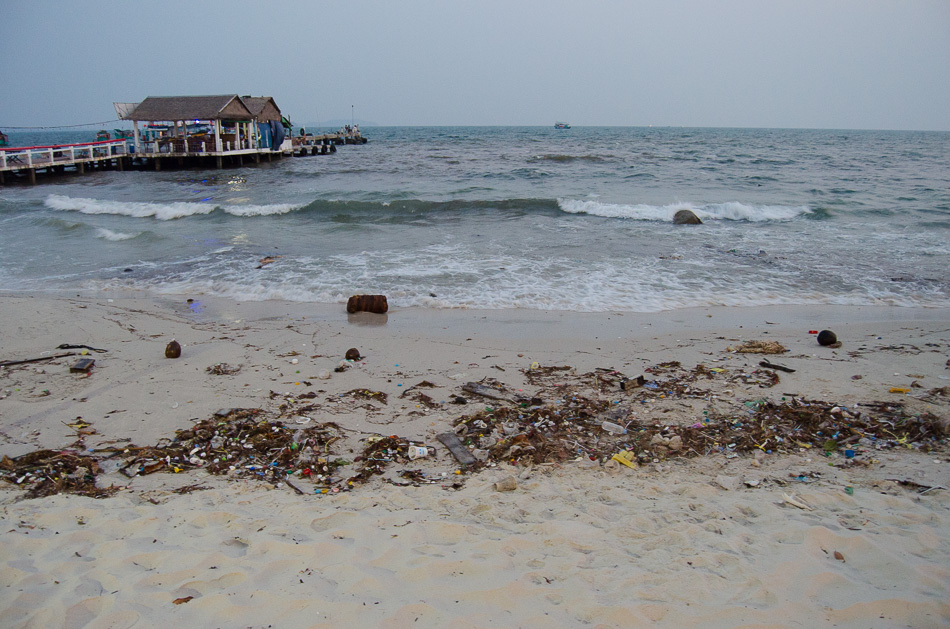
Serendipity is probably the best spot for wild party-prone backpackers. It’s full of party-oriented accommodations, bars, western restaurants, and tour agents selling tickets for booze cruises. If you’re looking for fun in the sun, this is it! During the day you can hang around the beach, swim, and eat barbecued corn or grilled skid from vendors passing by. As the sun begins to set, the music volume begins to rise and lounge chairs, tables, and torches furnish the beach for all-night partying.
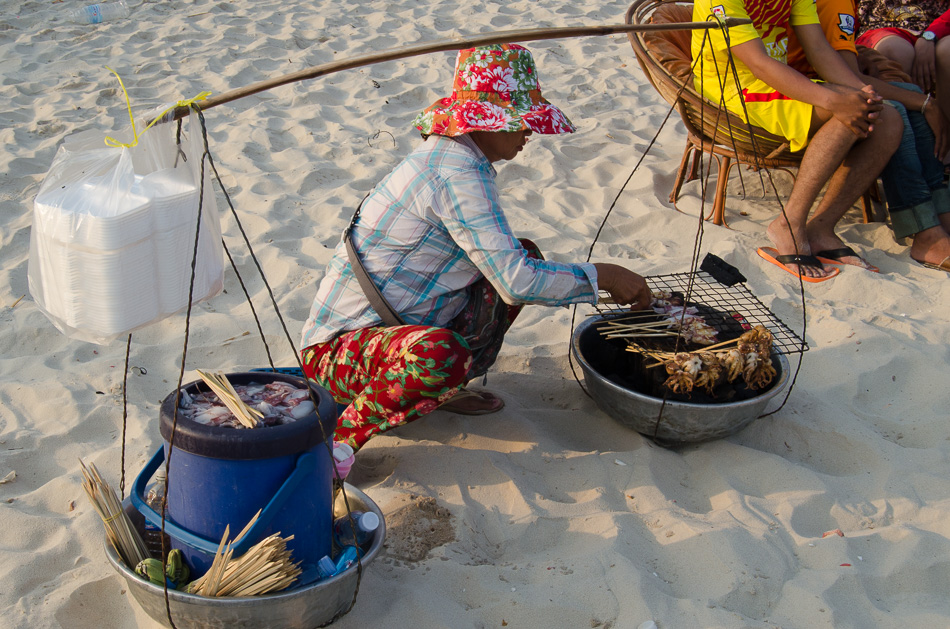

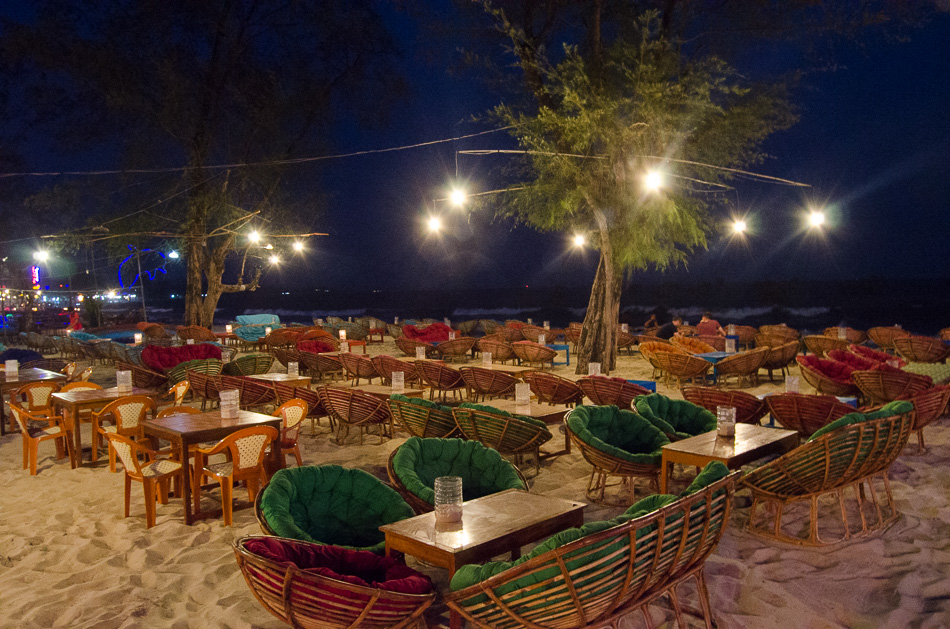
If you’re willing to walk around though, you can find beaches with different vibes. A 15-minute walk north of Serendipity is the peaceful Independence Beach, and pedaling for 25 minutes, can take you to Sokha Beach with tempting warm waters and white sands maintained by the resort close by.
Something peculiar we noticed in all Cambodian beaches was that most locals go into the ocean fully clothed. It was funny to watch dressed-up girls leaving their purses in the sand and getting soaked and pounded by the waves. I guess excuses like “I wanted it to get in, but I left my bathing suit at home…” are not valid here.
In Serendipity as in any other beach destination, meals tend to be more expensive.
Fortunately, we found a7 Makara Street 200, right next to the Golden Lions roundabout.
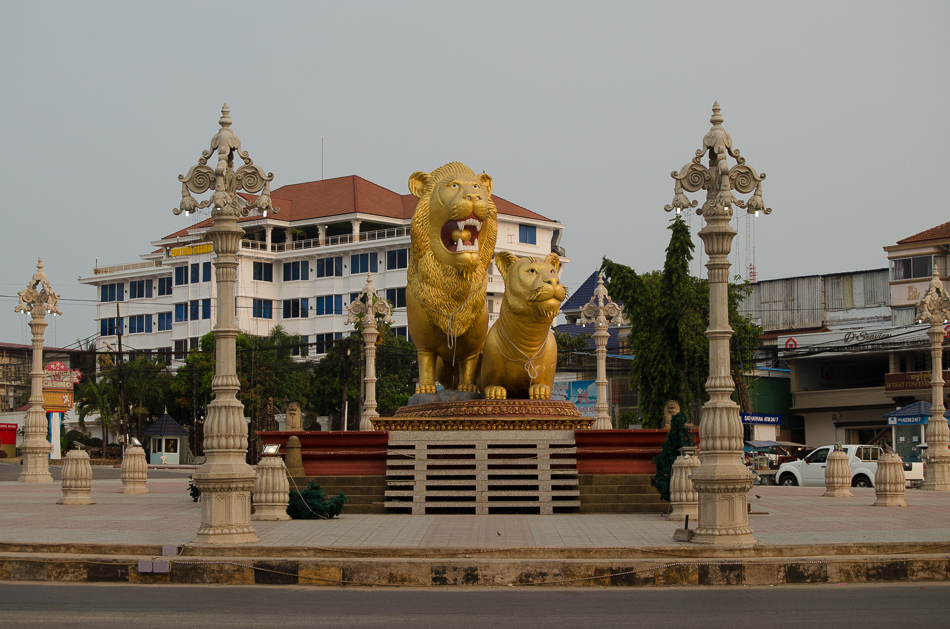
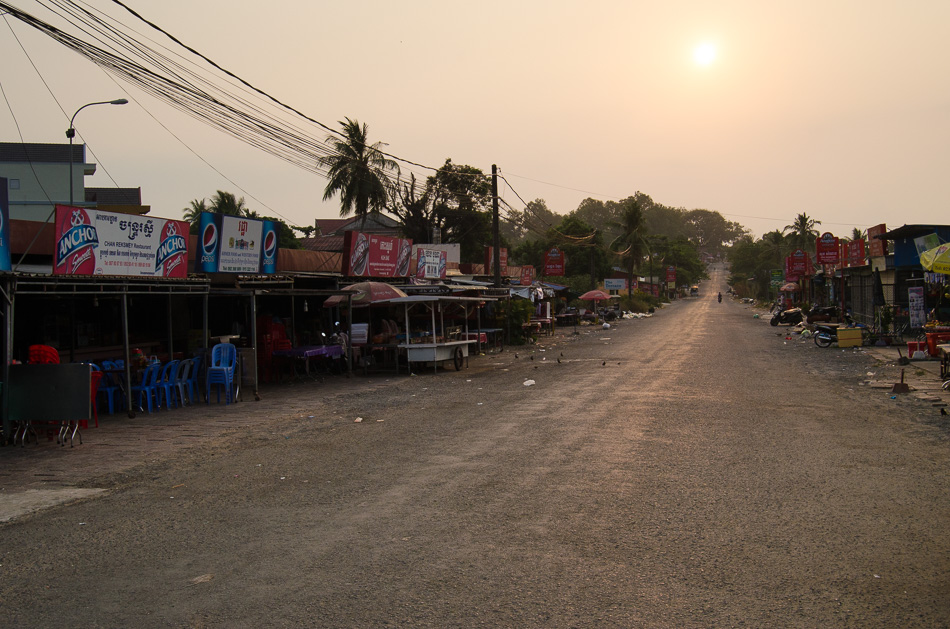
The street is flanked on both sides with local restaurants and our favorite was called Chanreaksmey—the average meal was $2.05. Go there and pick anything on the menu, seriously anything. You’re welcome! It had the best food I’ve tasted in our entire trip.
We stayed 6 days in Sihanoukville. 2 more than we’ve planned because we had to wait for our visas to be processed at the consulate of Vietnam. Being a well-known crossing point for backpackers traveling through South East Asia, Vietnam has a consulate here in Sihanoukville.
Kampot
We went from Sihanoukville to Kampot in a minivan. We bought our tickets for $5 in Champa. The trip took 2 hours and stopped near the Durian Roundabout — kind of a landmark here, just like the actual durians are.
If you prefer to buy your ticket to Kampot online, we recommend www.bookaway.com (use the code “gravy5″ at checkout you’ll get 5% off the ticket price).
Have you ever tasted a Durian? They’re like a creamy love child of a cantaloupe and a cabbage and have a really pungent smell. So much so that it is common to see signs prohibiting durians in hotel rooms and carriers.
Kampot is a quieter city along the River Praek Tuek Chhu: a river you can kayak, swim and go on sunset cruises with an occasional beer in the mix. Here you won’t find as many partygoers though.
Along the river, French influences are more noticeable in the architecture. You’ll find restaurants, bars, shops, and accommodations with slightly higher prices that you can avoid if you’re willing to walk a bit more into the city. Shops tend to close early, so remember to get an early dinner.
Our accommodation was near the durian roundabout: Sebana Guesthouse. We paid $7 a night, breakfast included.
Initially, we planned to stay 2 days in Kampot and 1 day in Kep, but Kampot felt right, so we decided to linger and rent a scooter to visit Kep — even without having driven one before. Ever.
Isn’t travel supposed to be about learning new things? We were honest about not knowing how to drive a scooter but that didn’t dissuade the renters. Apparently, the $5 scooter came with a driving lesson from an instructor experienced in novice drivers. He was calm, wise, and only knew about 3 English words, but in 8 minutes we learned how to ride a scooter and the 2 main Cambodian traffic rules:
1) Always wear a helmet
2) Never drive with the lights on during the day.
Traffic in Cambodia is wild! Let’s just say that speed limits are just reference points for pussies. Here, people drive in the opposite direction, talk on the phone, and use horns as their blinking lights, rear lights, and a way to say ‘hello’. And it’s also quite common to see 8-year-olds driving motorbikes, so there wasn’t much we could do wrong.
A couple of hours later we were at the Bokor National Park.
But don’t let the name fool you because it’s not like the ‘National Parks’ you’ve been on. Even though it has beautiful green hills and great views, there are no nature trails or wildlife to see. You can go on hikes, but a guide is recommended due to the risk of landmines still existing outside the pathways.
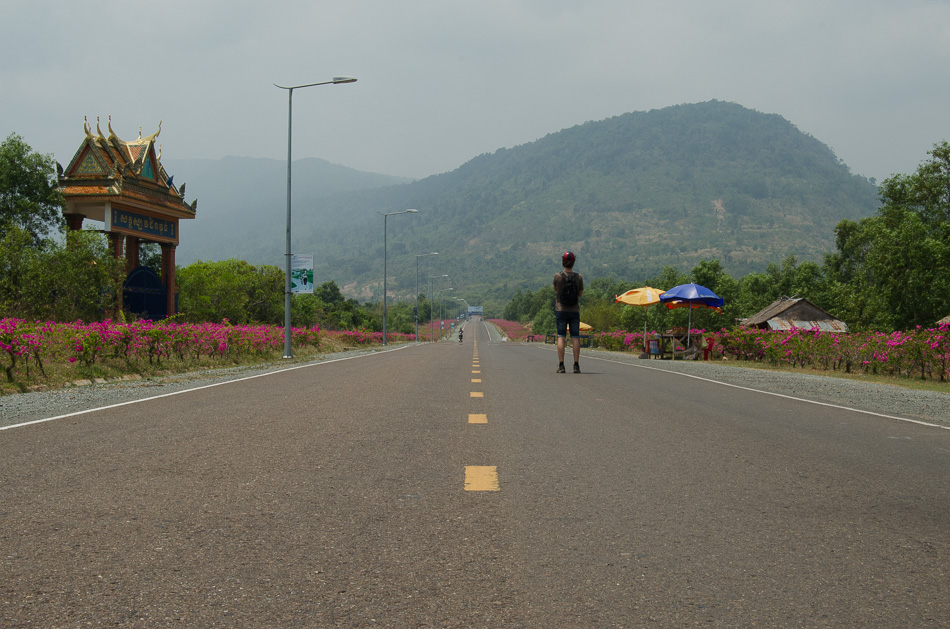
We used the long-swerve roads in the park to improve our riding skills. The roads passed by a big meditating Buddha (Lok Yeay Mao), old abandoned buildings, and an abandoned Casino at the top.
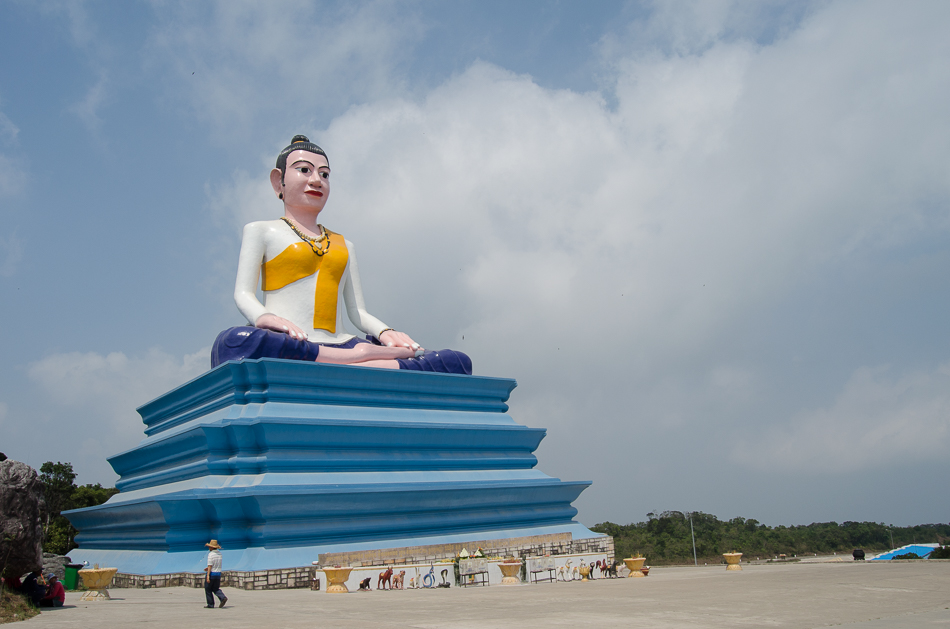
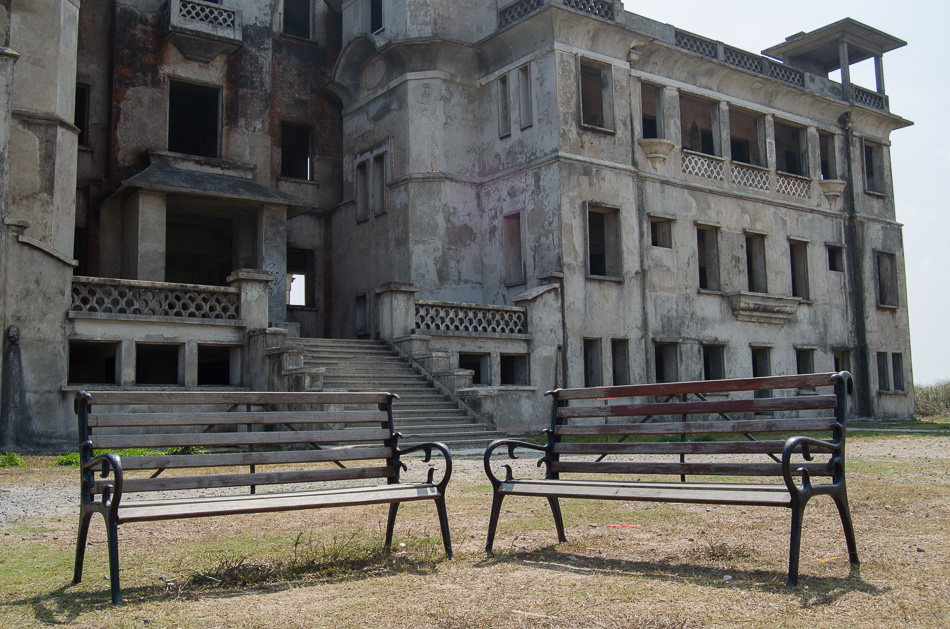
It’s worth the trip, the landscape is great all the way up and the old buildings are fun to explore, just make sure you take a jacket, snacks, and a full tank of gas.
Gas stations in Kampot give you free drinks and snacks when you fill your tank.
On our way back we did a little detour through red dusty roads with the intent of visiting the salt flats of Kampot. We arrived late in the afternoon and had the opportunity to watch some workers raking and hauling little piles of salt. It reminded us of the saltpans in Aveiro, our town back in Portugal.
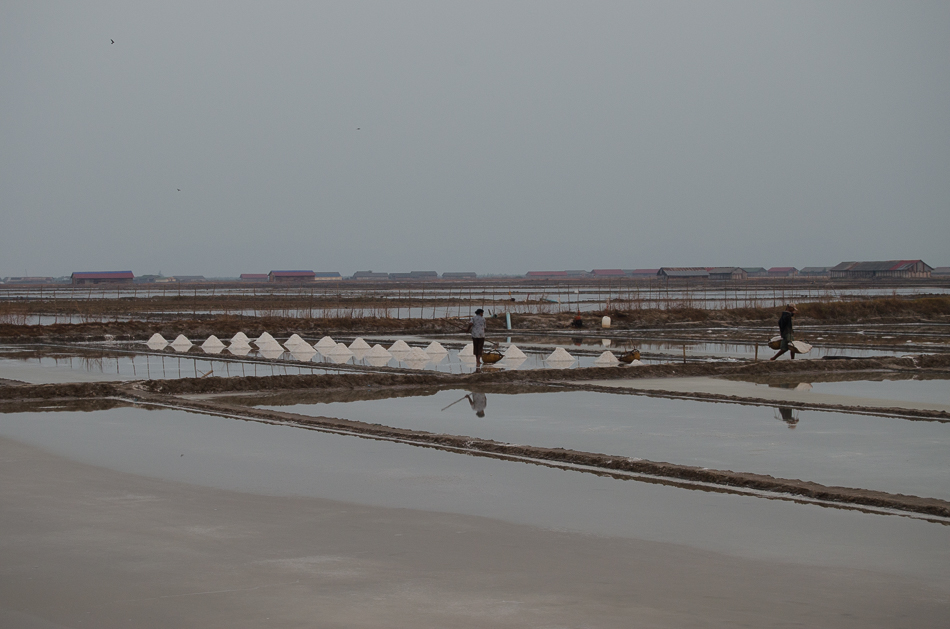
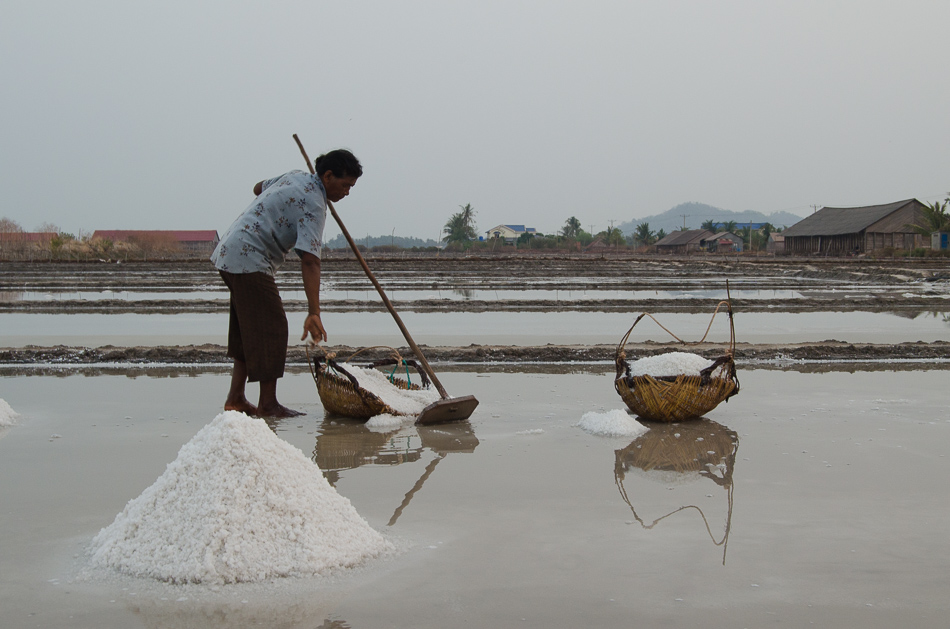
The next day we rented the scooter again and drove 1h30 to Phnom Chhnnork, a pre-Angkor temple inside a cave. You can get there easily using Maps.me and when in doubt, ask around, locals are always super helpful. The entrance fee to the temple is $1 and you’ll have the opportunity to go through a dark tunnel inside the cave.
You’ll find a bunch of kids with flashlights waiting to guide tourists through the tunnels, they speak good English and expect a $5 tip for the tour. But you can negotiate.
We didn’t cross the tunnel though, it felt claustrophobic and smelled like bat pee.
Salt and pepper
After the cave temple, we drove to La Plantation, a pepper plantation that was not easy to find. On the way there we stopped by the Secret Lake which turned out to be a dam and not a lake.
Cambodians grew pepper for over a thousand years before the European traders arrived. But with the help of the French during the colonial administration, production was augmented tenfold. Sadly during the Khmer Rouge regime pepper fields were abandoned.
Today the business has been reborn and is visible at La Plantation, a 10-hectare pepper farm specializing in the organic production of this hot spice. You can go on a free 10 minutes guided tour through the pepper fields, they’ll show you around and explain a little bit of the production process.
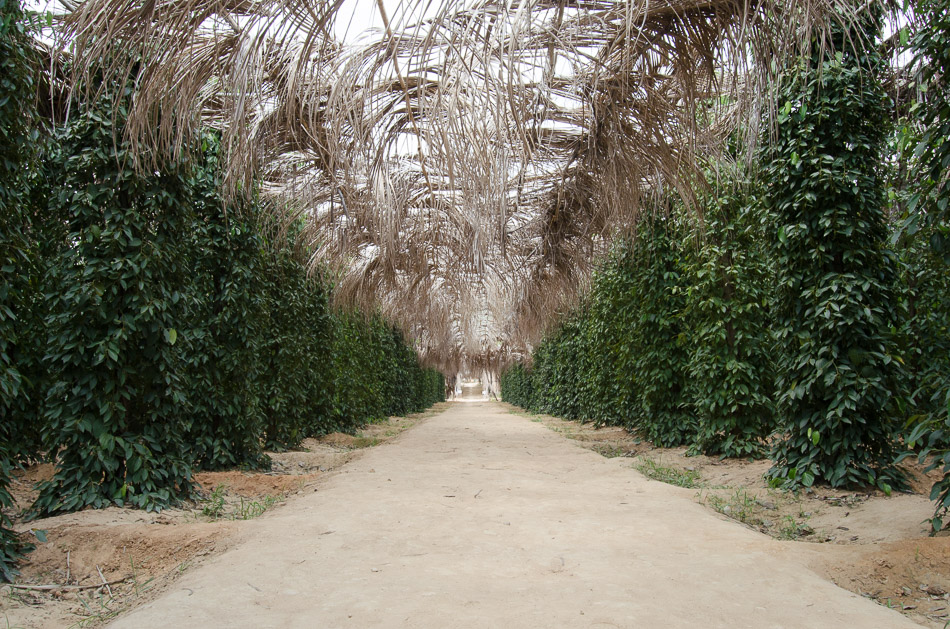
After the tour, they’ll take you to a little cafe on a gazebo to taste the peppercorns—and buy some if you want, of course.
Kep
We left La Plantation planning to have lunch at Kep, a town well-known for its great fish and seafood, but the sloping dirt roads and opposite information didn’t make it easy. The trip took us around 40 minutes.
The first thing we saw was the crab market, bustling with people negotiating over pyramids of seafood, fresh fish, grilled fish, and fruit. Restaurants overlooking the sea invite you in to taste the catch of the day, while fishermen walk along the seashore fishing for something more.
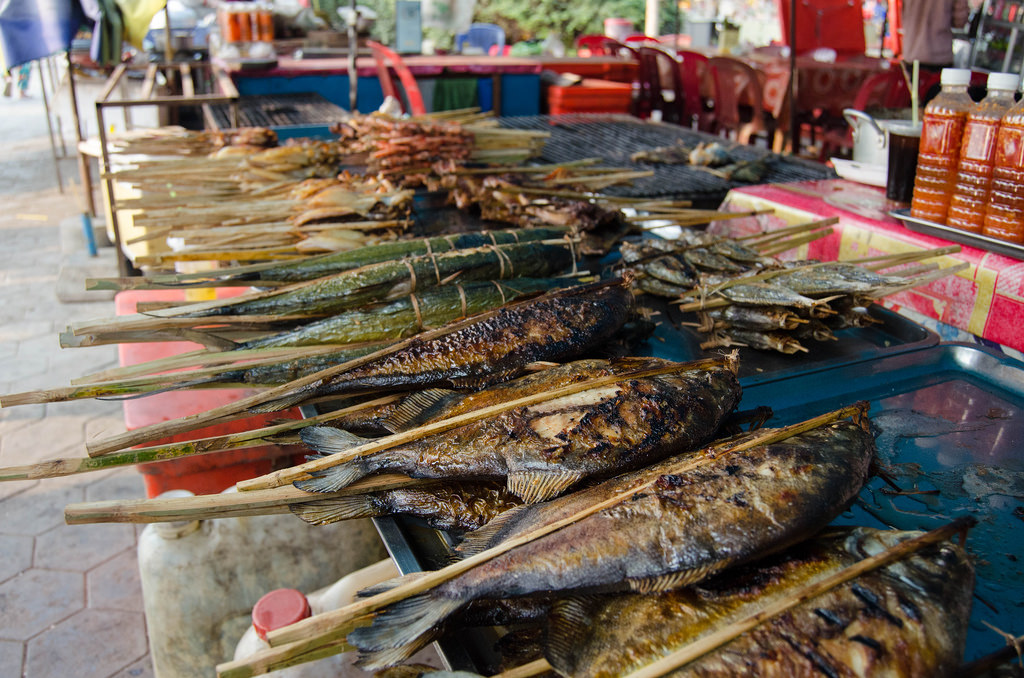

With a full stomach, we headed to Kep’s only beach, a small bay with a thin stretch of sand protected by hills that tend to get pretty crowded on the weekends. There weren’t many people around that day, just some local families picnicking on the sidewalks. We couldn’t find any town center as things seemed a bit scattered here and there.
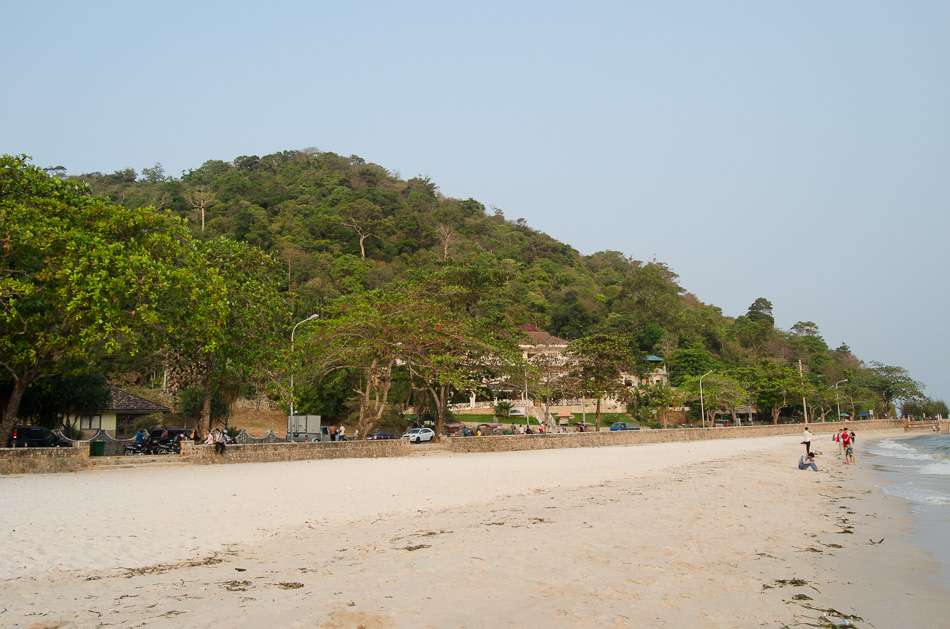
Southern Cambodia travel expenses (Daily average for 1 person)
Breakfast: 1,75€
Lunch and Dinner: 2,38€
Water: 0,36€
Coffee: 0,45€
Accommodation: 3,81€
Motorbikes: 4,48€
Full tank of Gas: 2,68€
If you have any questions or some extra info everybody can benefit from, please leave it in the comments!
Angkor Temples by Bicycle in 2 Days
If you want to explore the Angkor Temples, the city of Siem Reap will be your starting point. Here’s where you’ll find different transport options to visit the Angkor Archaeological Park at different price ranges:
• You can do it by yourself on a bicycle (US$3 a day)
• On a motorbike,
• In a group tour,
• Or by tuk-tuk (US$25 for a whole day, granting you a ride to all the main temples and back to Siem Reap). But just so you know, we saw a girl making a big scene after realizing her tuk-tuk abandoned her in one of the temples.
If you want to know more about the city go over to Siem Reap for First-Timers (What to Expect).
Choosing the Bicycle
Renting 2 bikes for 2 days cost us US$6.
Best decision EVER. We got to feel the warm breeze in our faces, the smell of the forest, and the freedom of stopping where we wanted for as long as we felt like. *Ahhh…*
All the Angkor temples are inside a beautiful and very well maintained park, with huge trees and vast vegetation where insects sing from. Locals come here to relax, swim and have picnics on the weekends.
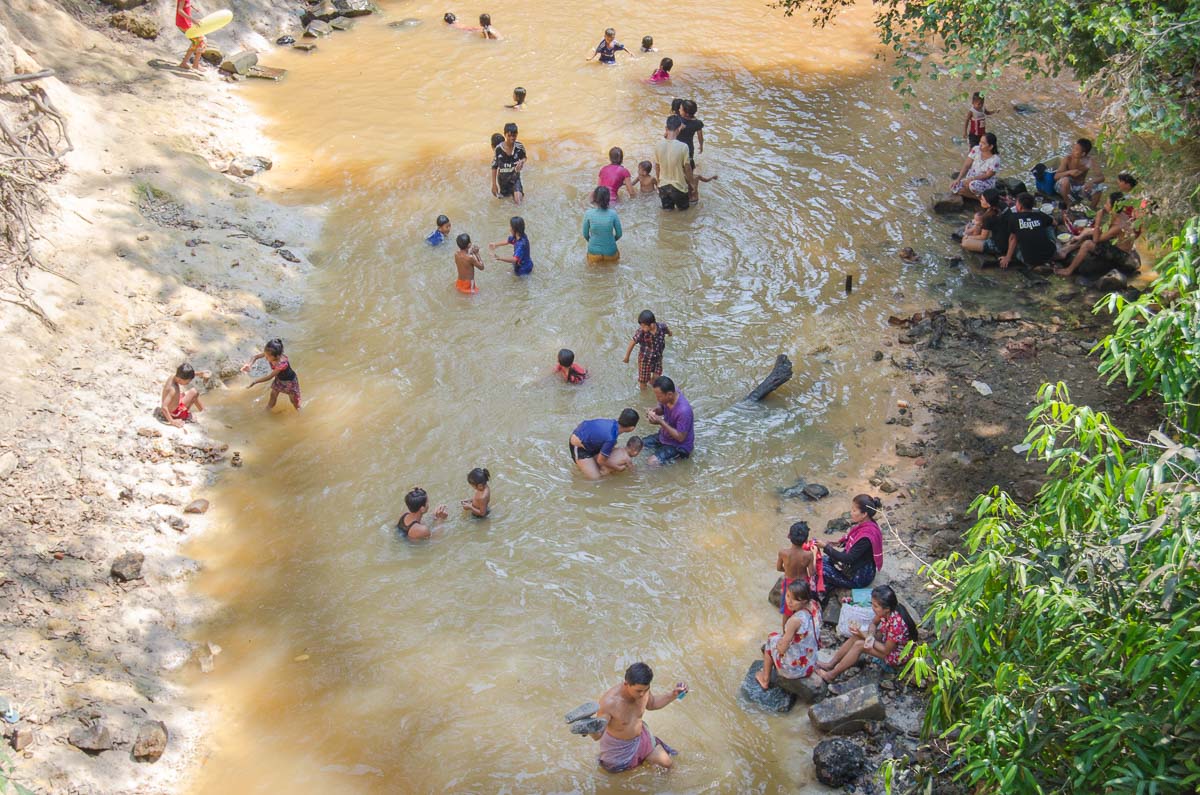
After 35 minutes through a long straight road, we arrived at the Angkor Archaeological Park and purchased our 3-day passes.
Angkor Admission Passes (2020)
7-day pass: US$72
3-day pass: US$62
1-day pass: US$37
Children under 12 years old are not required to purchase an entrance ticket but a passport needs to be shown as proof of age.
At the counter, you’ll have a photo taken and be given a pass/visiting card that you must carry at all times. Every day, as you enter the park a guard will check it. (That same guard also tried to sell us a tuk-tuk ride, even though we were on bicycles: “No problem my friends, put the bicycles in the tuk-tuk as well”). 😑
After cycling for 15 more minutes, we arrived at Prasat Kravan, a small temple made of three red-ish brick towers and surrounded by a dried moat. The temple is in pretty bad shape but is still possible to see the bas-reliefs dedicated to Vishnu.
Reaching Banteay Kdei, the second temple, took another 15 minutes. The temple is surrounded by a wall, like most of them are. We got in through a narrow and detailed doorway and walked along a stone road before reaching the main building. Parts of the building have collapsed, but most of it is visitable. Nowadays the fallen stones are organized in piles (for inventory) and several walls are now supported by iron and wooden beams.
The work behind all of this is mind-blowing: the transportation of raw material, the skilled men that cut the stone to fit impeccably together, and the intricate sculpture work throughout the building…wow.
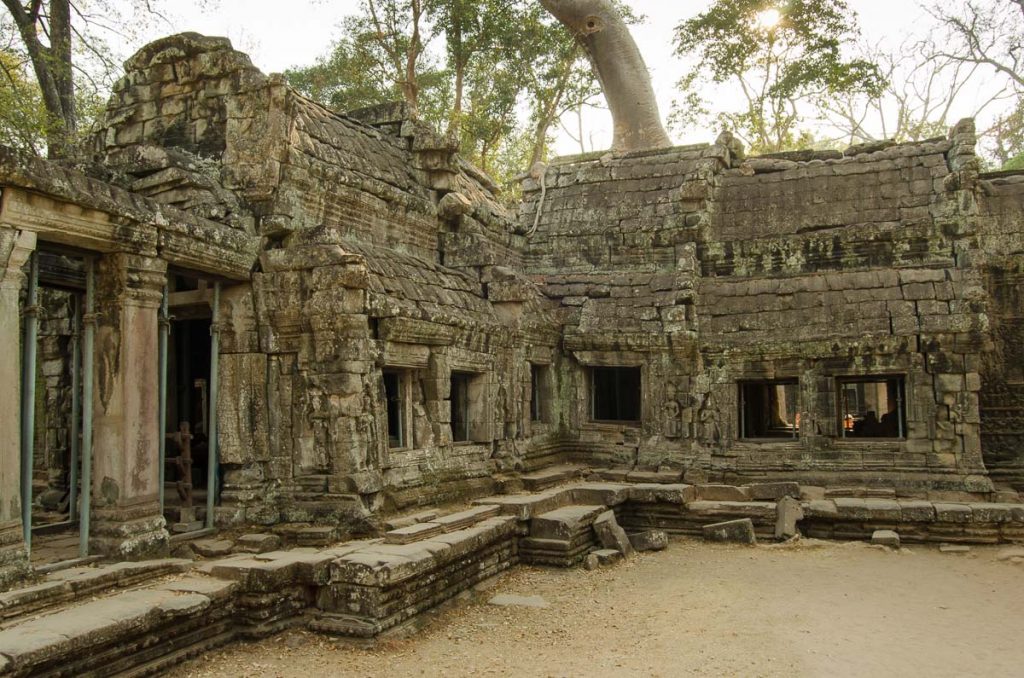
The Angkor Temples are considered religious sites as well: you’ll find many Buddha statues decorated with gold and orange cloths, with incense and offerings laying at their feet. It’s great to see that the temples are still alive and serving a purpose besides being a visiting site for tourists.
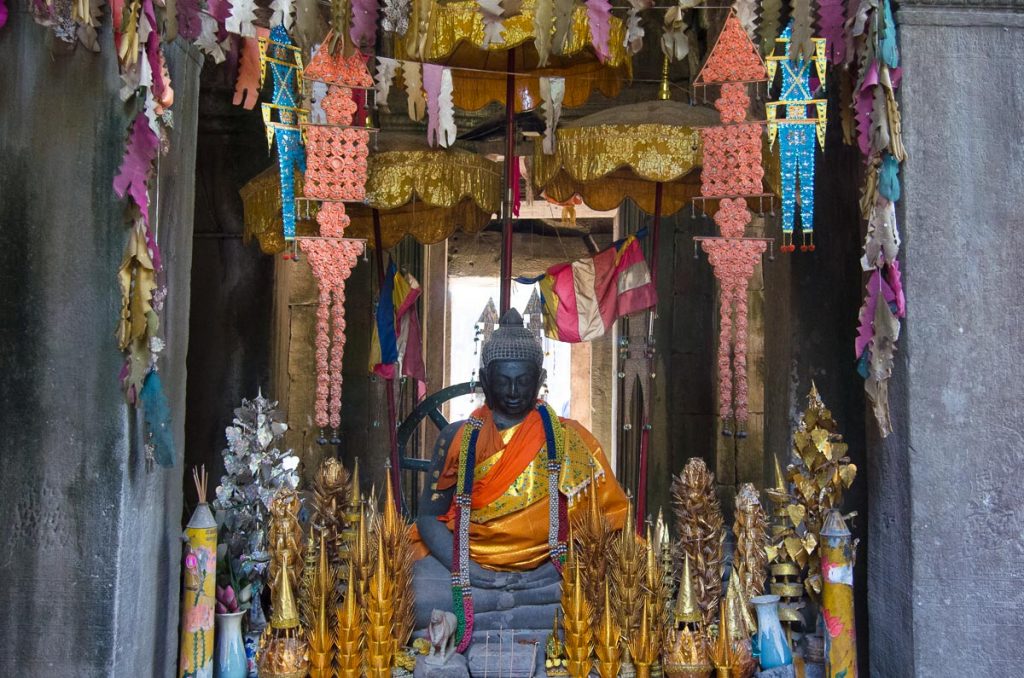
In front of Banteay Kdei is an enormous lake called Sra Srang. The lake was used by the crowned heads back in the day, for bathing and playscape — basically a bathtub to fit their egos.
Eating on the Archaeological Park
We’ve come to realize that when tourists are having lunch is when you’ll have a better experience in famous tourist sites. So as we usually do when visiting this type of monument, we only stopped for lunch around 4 pm.
At the temple complex, food and drinks are way more expensive than in Siem Reap (four times more expensive) so be prepared and stock up!
Ta Prohm
After lunch, we headed to Ta Prohm, one of the most recognized temples due to the Tomb Raider movies. Here, nature took back the place. Giant trees with a magical golden bark grew on top and around the walls finding a beautiful balance between weight and support. No one knows who’s holding whom. Pure magic.
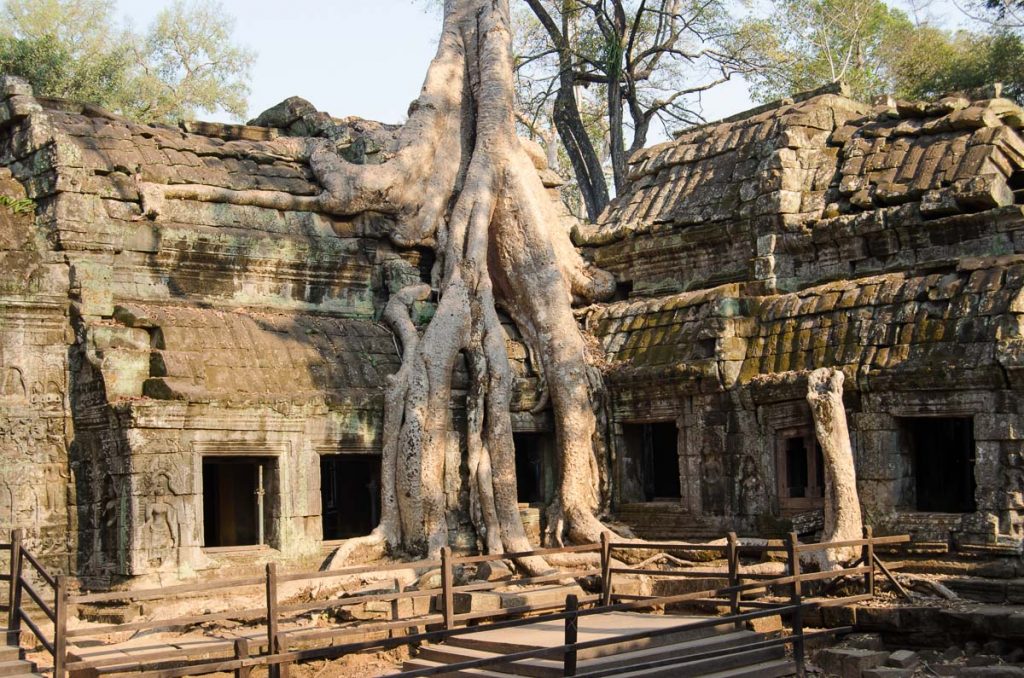
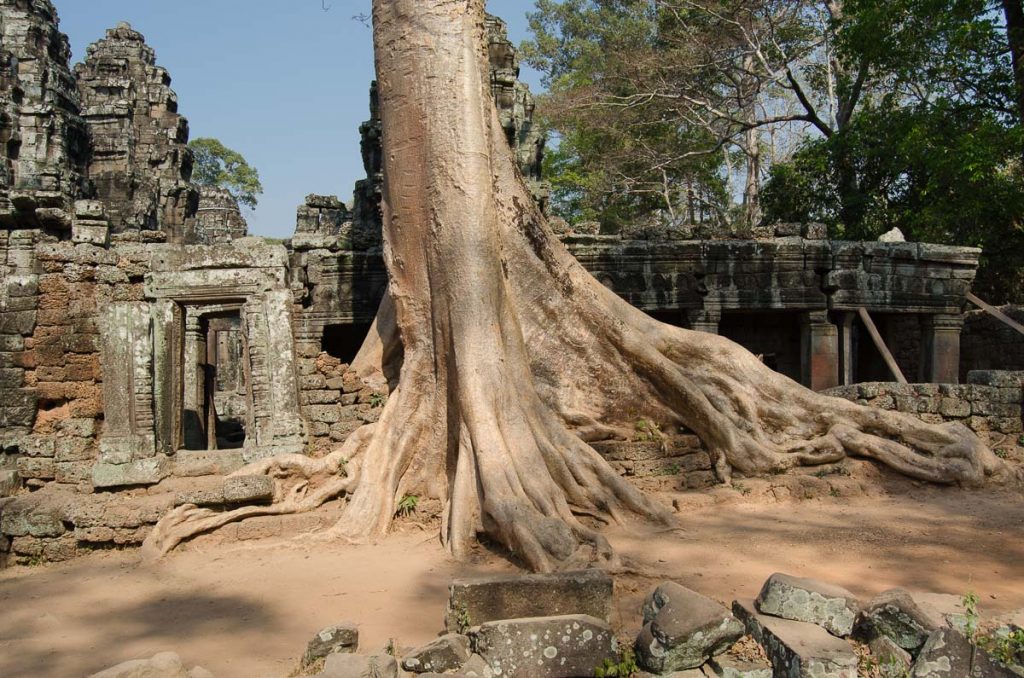

By 5:30 PM we headed back to the city. The park closes at 5:30 PM.
Most temples in the park can be visited from 7:30 AM – 5:30 PM (except for Phnom Bakheng and Pre Rup that close at 7:00 PM).
The Second Day Visiting the Temples of Angkor
The second day as we biked to the park, a bunch of monkeys welcomed us by the road, it was our first time seeing monkeys on the loose like that.
We knew it was going to be a great day, we’ve just been greeted by monkeys and we were about to visit the BIGGEST TEMPLE IN THE WORLD: Angkor Wat.
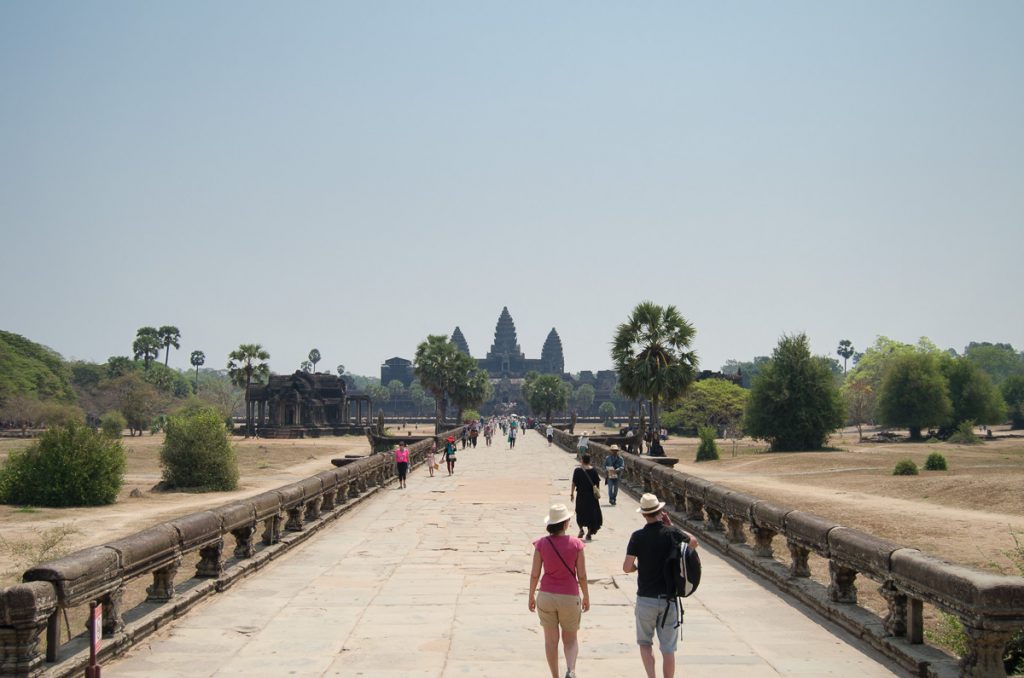
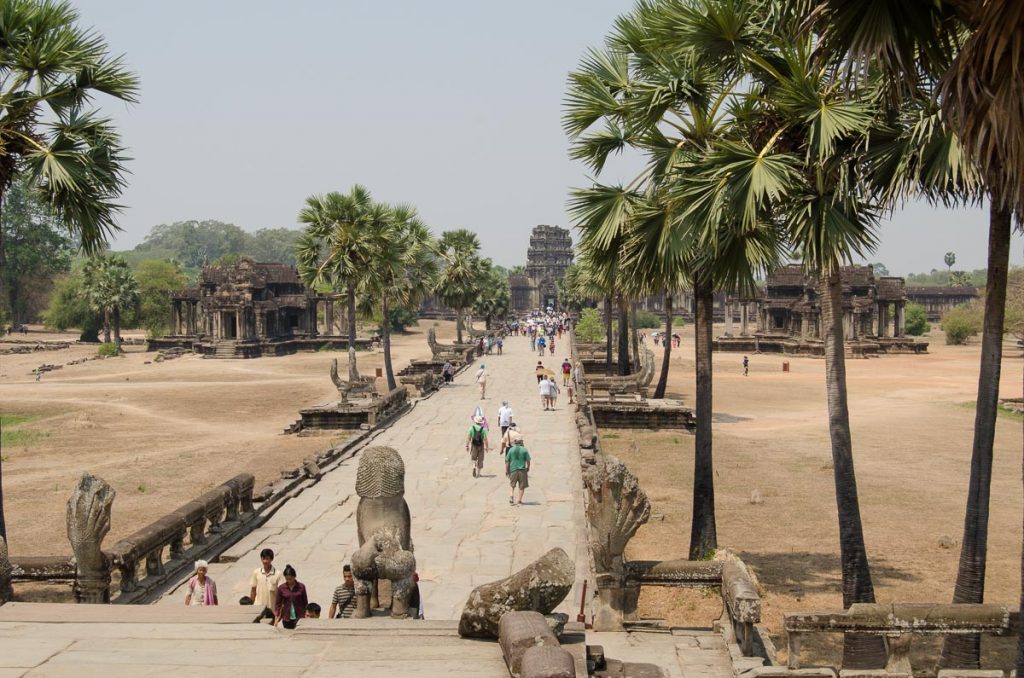
Surrounding Angkor Wat is a moat the size of a river and the only way to reach the temple is through a stone passage. At the start of this passage was a frenzy of people, locals, tourists, tuk-tuks, buses, and food carts. Funny how we thought we would be first to arrive…

As soon as our eyes got through the wall of people and faced Angkor Wat in all its glory, bathed by the morning light, we got chills. Wow! Just as seen on TV.
But after visiting the interior of the temple, we can say that Angkor Wat is kind of overrated. Yes, it is the largest and the tallest, and once you climb its central section the view of the park is epic. But that’s pretty much it.
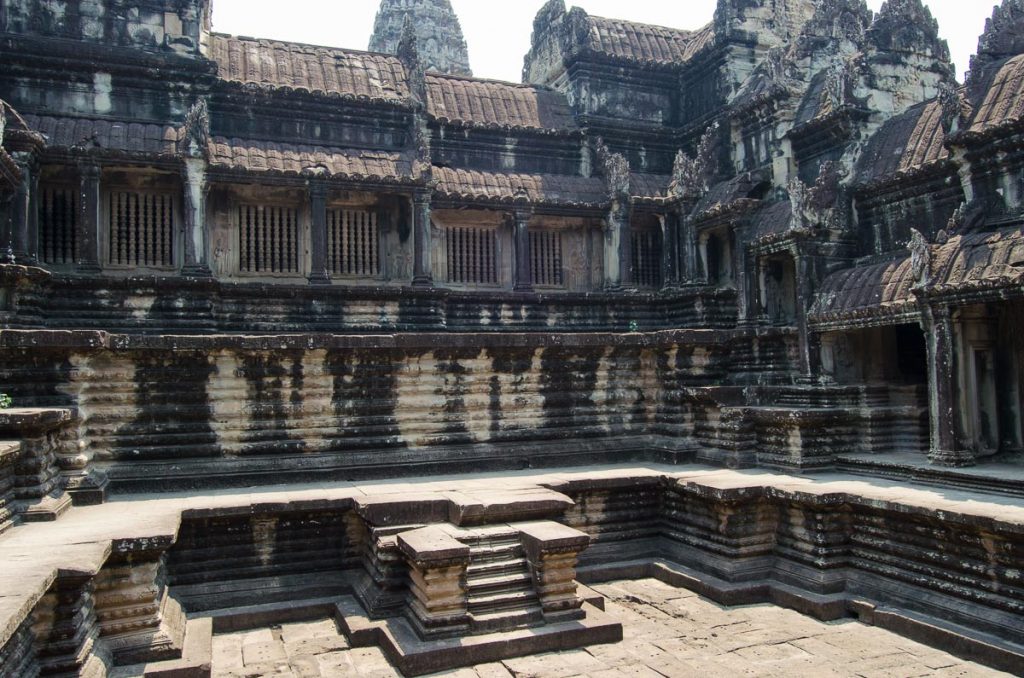
There are smaller temples with better sculptural detail and a magical ‘je ne sais quoi’ that we didn’t feel in Angkor Wat. It felt a bit sterile and dry compared to other temples that time managed to marry with nature.
After having lunch at one of the restaurants by Angkor Wat, we biked under severe heat to the old town of Angkor Thom: it’s a giant walled area with several temples inside. The north and south entrances are flanked by imposing statues of men battling demons.

Minutes after passing the entrance, we arrived at other of the most recognized temples in Siem Reap: Bayon. It’s the one with many faces — 216 to be exact — built by a king that wanted his face sculpted everywhere to impose respect from anyone observing the temple. Other amazing features are the extensive, well-conserved bas-reliefs walls portraying stories of battles and Khmer’s everyday life.
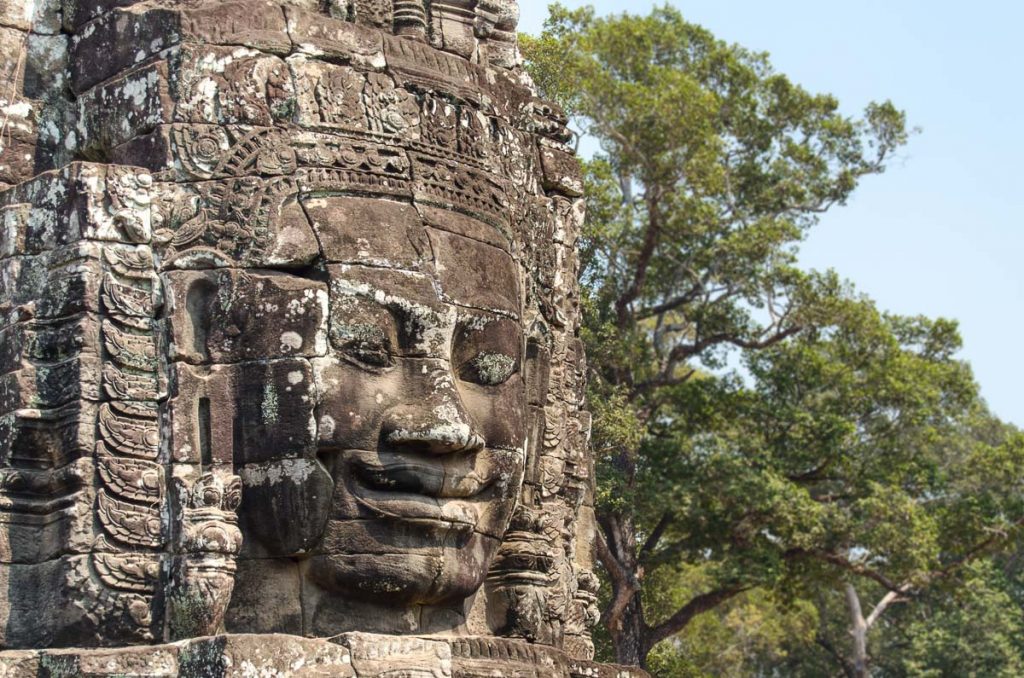
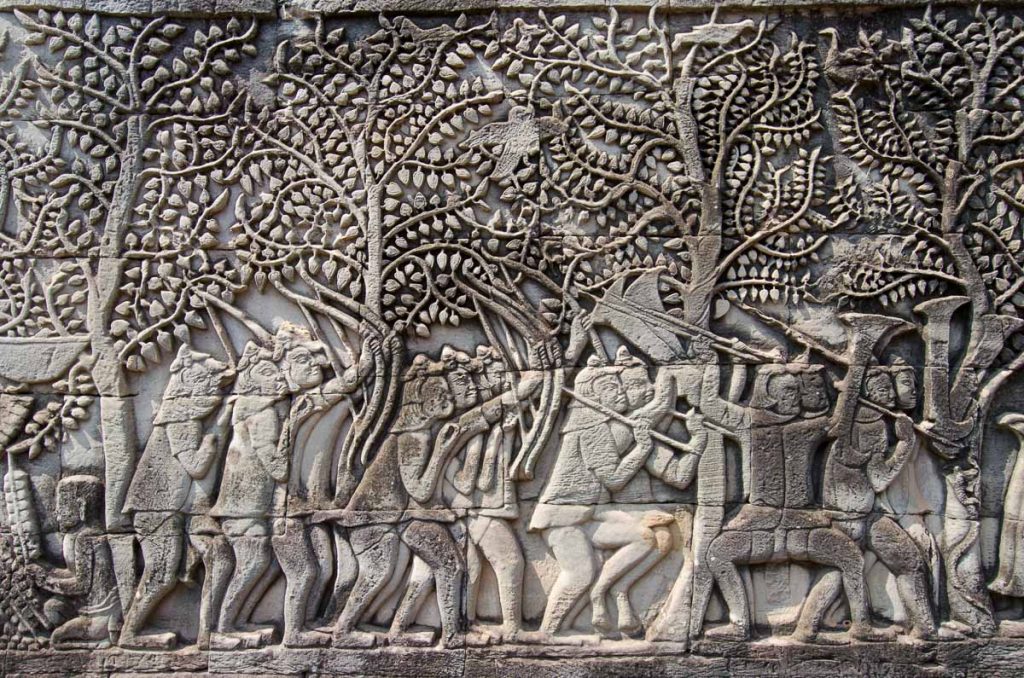
To the left of Bayon is the Baphuon temple in which we didn’t get in. The fatigue and the heat dissuaded us from climbing the 5 or 6-meter platform where the temple seems to be built on.
To be honest, we were feeling ‘templed out’ and regretting choosing a bike as transportation. Just the thought of all those kilometers ahead of us made us want to cry.
We decided to sit in a shaded spot and rest our sore legs.
Accepting the pain and keep going
Back on the bikes, we got to an open space with trees and the ruins of twelve towers. On one side was Prasat Suor Prat, and on the other was the Terrace of the Elephants. The terrace is a 3-meter-high platform used way back when for royal ceremonies and military parades.
We left Angkor Thom and headed to the temple Preah Khan: it once served as a town, temple, and Buddhist university. The restoration work in Preah Khan was minimum, being purposefully left as it was found.
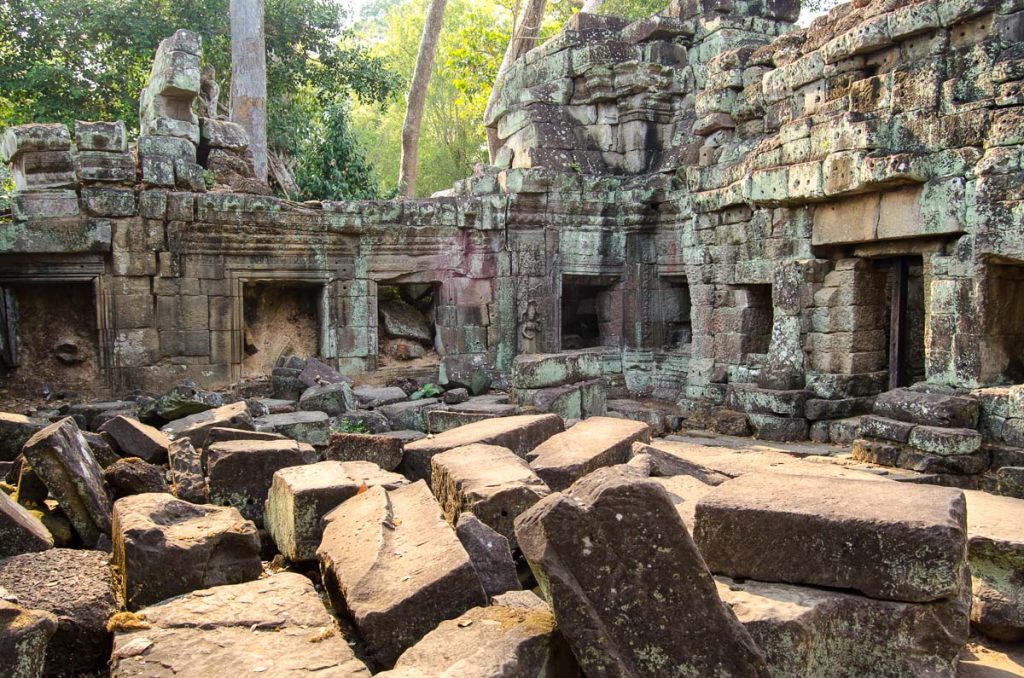
The bike ride back to our hotel was actually great. It gave us time to reflect and absorb what we’ve had witnessed and to say goodbye to Angkor as the sun went down. What an amazing experience: two full days witnessing epic history and actualized human badassery that will certainly remain in our hearts forever. Way longer than the pain in our legs.
Angkor travel expenses (Daily average for 1 person)
Meals: 3,77€
Water: 0,87€
Bicycles: 1,33€
3-day pass: US$62
If you have any questions or some extra info everybody can benefit from, please leave it in the comments!
Siem Reap for first-timers (What to Expect)
After the whole border situation entering Cambodia, we arrived in Siem Reap hesitant about the days to come. You can read the whole story here → Crossing the Infamous Poipet Border in Cambodia.
Siem Reap is a “small city” that rapidly grew and adapted to the massive tourist influx at the expense of the Angkor Temples. A river also called ‘Siem Reap’ divides the city in two. In the Royal Gardens, you can rest and escape from the afternoon heat under the old trees. Here’s where locals come to relax on the benches, socialize and play jianzi.
The sunlight has a magical deep orange hue and the city seems to be calmer around this area. There aren’t many people in sight, only a few local passerbyers, and businesses seem to be slow as most tourists are hiding from the heat or visiting the Angkor temples.
At the beginning and end of each day, an amusing anarchy in traffic starts. Cars, tuk-tuks, and minibusses packed with tourists come and go to the temples. Scooters and bicycles run wherever as fast as they can. Sidewalks are parking spots and pedestrians are forced to walk on the road — it’s every man for themselves.
Breathe in, breathe out
In Siem Reap, tuk-tuk drivers are next-level annoying. All they want is to take you on a tour of the temples or sell you some cocaine — both preferably. They’ll be parked on random streets, and outside every restaurant, hotel, and coffee shop waiting for tourists.
At the moment they see you asking for the bill in a restaurant, they’ll start touting. They will shout, whistle, clap, and hiss to get your attention. It’s intense. Breathe in, say ‘thank you’ and keep moving.
Tasting the gravy
Khmer food is amazing, and Cambodians are like wizards of pepper: amouk is great, Lok Lak even better. The spicy mango salads and the pork with pineapple are to die for.
Try all of the above with a fruit smoothie, any fruit smoothie.
We had the majority of our meals in a great restaurant called Moul Chheng Heang, near our hostel. The food was delicious and so were the prices, but what made us return every night, was the lovely enthusiastic lady running the restaurant.
She finished every sentence with:
– Yeah, yeah!
And lovingly made us promise we’ll return the next day.
– See you tomorrow. Ok?!
– Ok.
– Yeah, yeah!
Tip: The average street food costs 2,5USD. In restaurants near Pub Street meals start at 7 or 12USD. In most supermarkets, water is more expensive than in restaurants.
A dolla’ makes them holla’!
It’s weird to see an entire country on the other side of the world running on dollar bills.
Throughout Cambodia, you’ll need US dollars for everything: food, hotels, entrance fees, and transportation. They don’t care for their currency, so if you try to pay anything in Rhiels, they’ll roll their eyes at you.
Oh! And you better keep the dollar bills in pristine condition or they won’t take them.
The problem with the dollar bills is that everything got more expensive. There aren’t any nuances in prices and everything got rounded up to 1USD, 5USD, or 10USD.
Banks will give you dollar bills by default when you use any ATM, and the average fee is 4USD for each withdrawal.
A tip for European travelers: even though there’s a money-saving tip on Lonely Planet about Canadia Bank not charging any fees, it doesn’t work for European debit or credit cards.
Pub Street at night
Everyone comes here when the sun goes down: locals, backpackers, and tourists of all ages come to eat, drink and shop around. The street is filled with restaurants, massage parlors, coffee shops, and bars. And there’s always a happy hour somewhere.
Color is everywhere: in the neon lights of the bars, the tropical fruit in smoothie carts, the brightly lit bridges, and in the night markets on both sides of the river — Old market, Angkor market, and Night market.
Interacting with locals in Siem Reap
Unfortunately, every conversation that occurred was intended to make a sale and was definitely not in our best interest. As tourists, we got singled out and only treated as such. Locals couldn’t care less about your presence, so conversations never happened.
Siem Reap travel expenses (daily average for 1 person)
Water: 0.28€
Accommodation: 14.20€
Bicycle: 2.66€
Meals: 3,10€
Laundry: 0.87€ per kilo
If you have any questions or some extra info to share, please leave a reply. Thank you!
Crossing the Infamous Poipet Border in Cambodia
Advice on Cambodia Visas
If you’re considering crossing the border by land from Thailand to Cambodia through Poipet, we recommend getting an E-visa beforehand at www.evisa.gov.kh.
The e-Visa costs 35USD (5USD more than the visa on arrival) but it’ll save you from the stress and the “processing fees” charged on the land border. Better yet, if you want to cross the border smoothly, do it by plane as there are no scams in Cambodian airports.
What happened to us when crossing the land border to Cambodia was quite stressful. The infamous Poipet lived up to its reputation.
We woke up after a really bad sleep in Bangkok, to catch the 5:50 AM train to the border town of Aranyaprathet for a 7 hour trip through the central plains of Thailand. It’s a really pleasant trip that costs 48THB.
(By the way, if you’re looking for transportation from Thailand to Cambodia check www.bookaway.com. They have plenty of options at great prices, plus, if you use the code “gravy5″ at checkout you’ll get 5% off your ticket price).
We started with a plan
It’s important to say that every plan or decision we make comes from what we’ve learned from travel books, blogs, the experiences of other travelers, and a little dash of intuition of our own. We do our homework pretty well. Studying and preparing ourselves with a good itinerary and a plan.
The plan for the day was to get off the train in Aranyaprathet, get a tuk-tuk to the Thai border for 80THB, get a stamp from Thailand to get out and a stamp from Cambodia to get in. Simple.
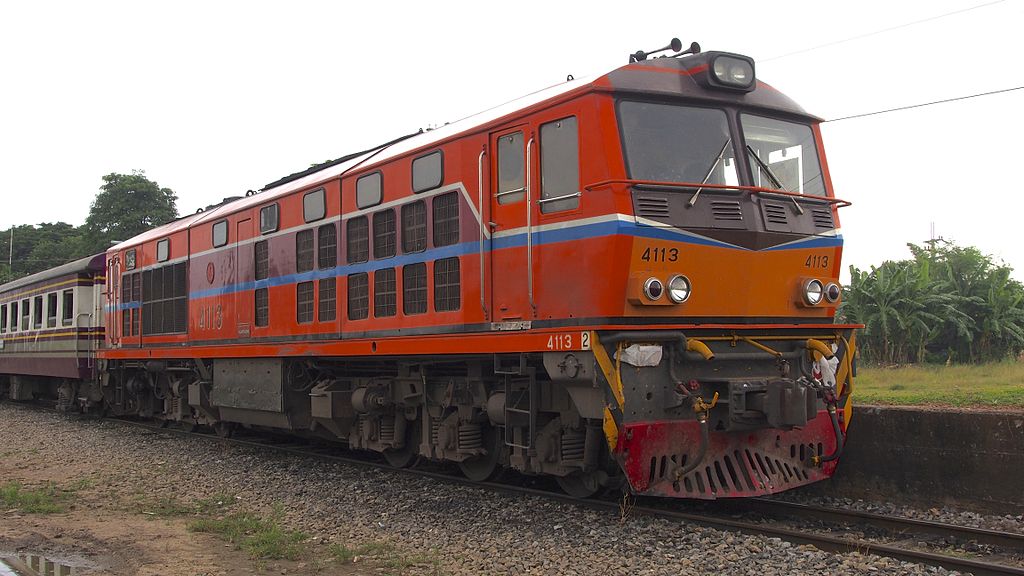
Clay Gilliland
The tuk-tuk cost us 200THB for a 10-minute ride. Fortunately, we ended up sharing the tuk-tuk with two American backpackers: Ryan and Winslow, that we had the pleasure to get to know along the ride.
At the Thai border (Aranyaprathet)
As soon as we got to the Thai border, we started walking to the building along with many other tourists and backpackers. There was a local market around, lots of tuk-tuk drivers and other random men. We immediately followed Winslow — the seasoned traveler from New York, coming to Cambodia for the second time.
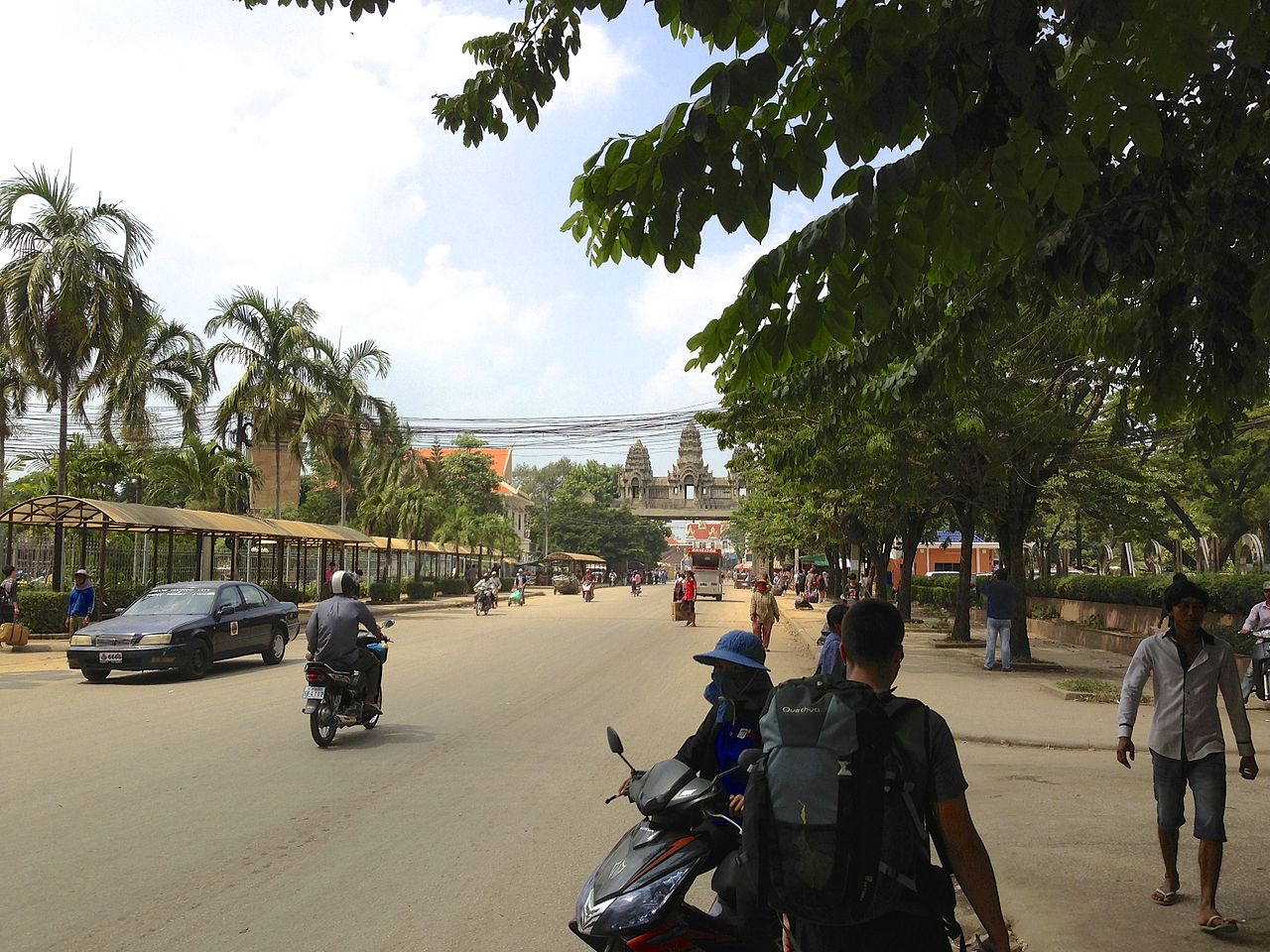
Clay Gilliland
Inside the building at the foreigners’ queue, we filled the departure card, handed over our passports, got a photo taken and our passports stamped. Super easy!
Went down some stairs and entered no man’s land and a bridge over stagnated water. At the end of the bridge, some dodgy men in hats were allegedly selling illegal visas, but none of them approached us. We just kept walking to the right end of the bridge into the Cambodian border offices.
The welcoming party at the Cambodian Border (Poipet)
As soon as we got in, a government official gave us a form to fill in.
We filled the form and prepared a photo, our passports, and the 35USD each (just as it said in every textbook, travel site, and in the big sign above the office counter). As we tried to hand them to the border officials behind the counter, they refused to take them, pointing to a handwritten sheet of paper that said “35USD + 100THB”.
So there we were in front of border corrupt government officials, trying to extort some extra money from tourists crossing the border. Just exactly as every textbook, travel site, and Winslow warned us. Great…
A little intimidated Nuno and I (plus all the riled-up backpackers in the queue) refused to pay the processing fees, which only made the officials speak louder in Khmer and point extra hard to the “100THB” in the paper.
The waiting game
Seeing that we weren’t going to give in, they took us aside, made us sit on some plastic chairs, and ignored us.
By then everyone is annoyed, anxious, and tired from the long train ride. After what felt like forever, a cranky officer came and took our passports and forms.
20 minutes later he came back, yelling our names and handing out our passports and visas. We got out of there as fast as we could.
Still trying to process what had happened, another officer took us to another long queue. This was the queue to get our visas stamped. Now, unfortunately, there was a power outage and no power means no processing tourist visas. So we had to wait. Under a boiling metal roof.
After 20 minutes, the power finally came on. Once again, we gave our passports to the officer, he took a webcam photo, moaned something, stamped the passports and we got in.
Siem Reap off!
After this whole border mess, we just wanted to get to the next bus to Siem Reap.
From what we’ve read, the bus station was nearby and the bus would prevent us to get ripped off by taxi drivers that wait for tourists at the Poipet border roundabout.
Ryan, the backpacker we met at Aranyaprathet asked Winslow, Nuno, and I to share a taxi. Our minds were still fuzzy from the heat and the border stuff, so we said yes!
We just wanted to calm down, and rest.
The taxi ride was 2h30 and cost us 48USD. Quite expensive considering it was not a taxi at all. Just a dude in a car, moving people from here to there in his spare time.
At least he had air-con and promised to leave us at our hostels.
Arriving at Seam Reap, the driver turned in a random street, pulled over, and told us to get out. We had no idea where we were, and outside the car, a group of Cambodian men were already taking our backpacks from the trunk. Something wasn’t right. And it the second time that day we felt like shitting our pants.
Winslow was the first to get out of the car and started yelling at the driver. Things got pretty heated and the Cambodian men started surrounding Winslow and us.
Basically, it was all a scam:
The fake taxi driver overcharges tourists at the border and dumps them in that corner of Siem Reap where other tuk-tuk drivers await. The tuk-tuk drivers will then take the tourists to their hotels – for more money obviously – and ideally get booked to show them the Angkor temples for the next days.
Winslow refused to pay the taxy driver and refused to go on any tuk-tuk, screaming and threatening to call the police. By now the tuk-tuk drivers were also yelling, laughing, and making fun of him, which only made things worst.
What the f*ck have we got ourselves into?
Shit was about to go down when the taxi driver, backed down from the argument and said he’d take us to our hostels. As soon as we saw the famous Pub Street, we got off the car and figured the rest out.
Not a good first impression of Cambodia.
It was quite a rough day but hey, it’s all gravy!
